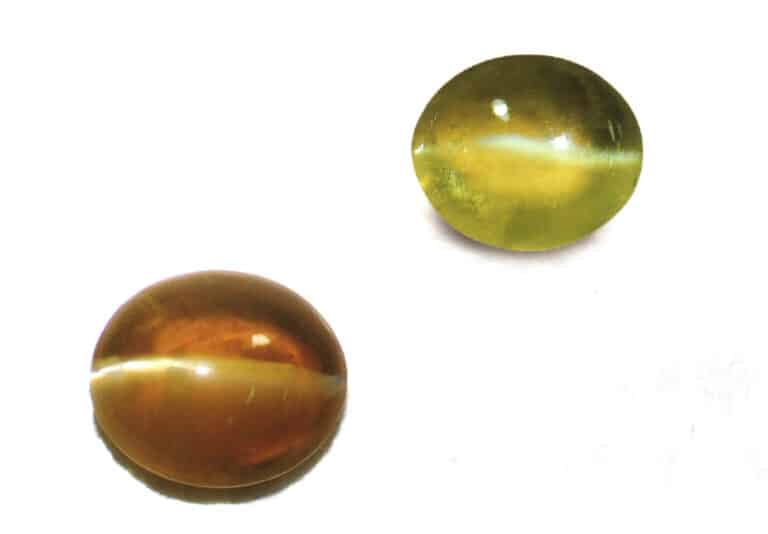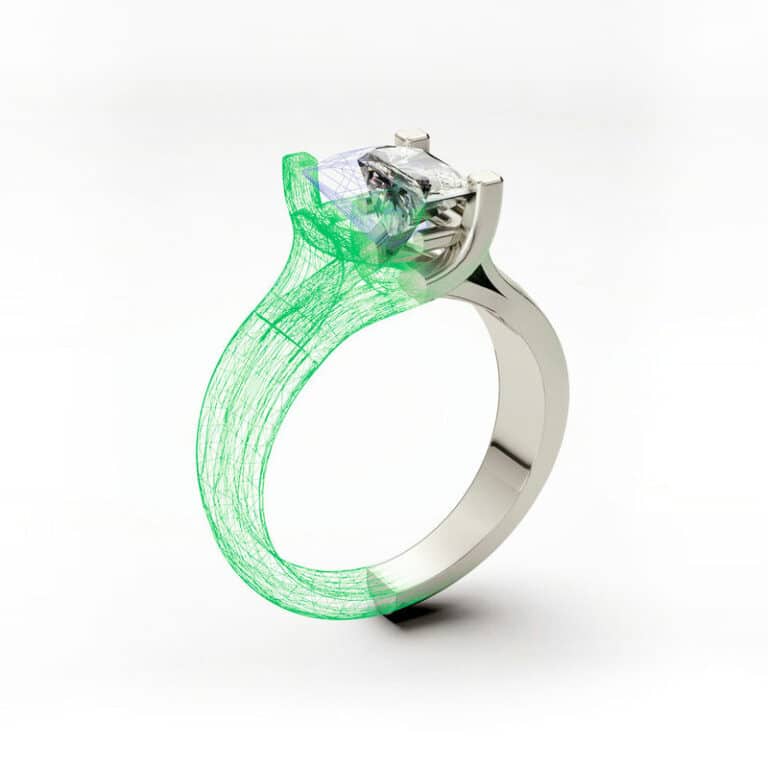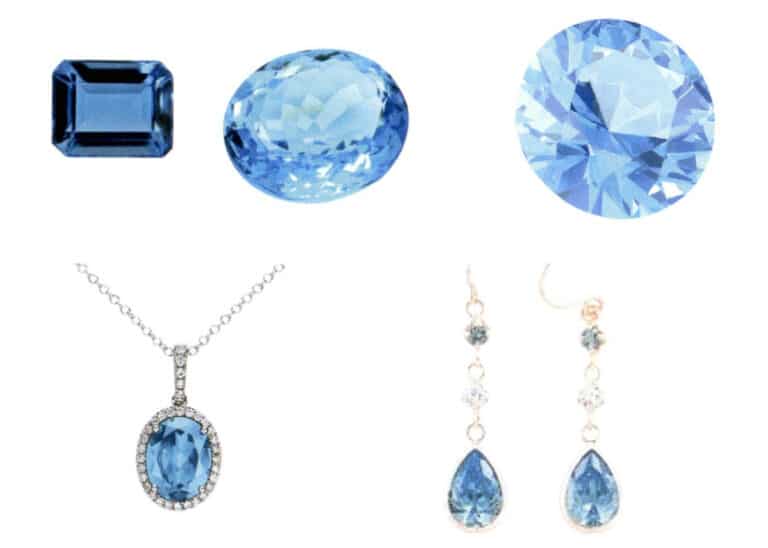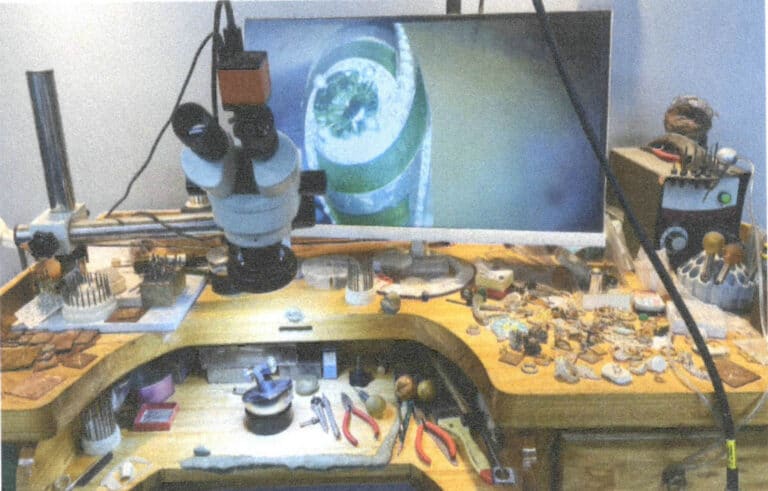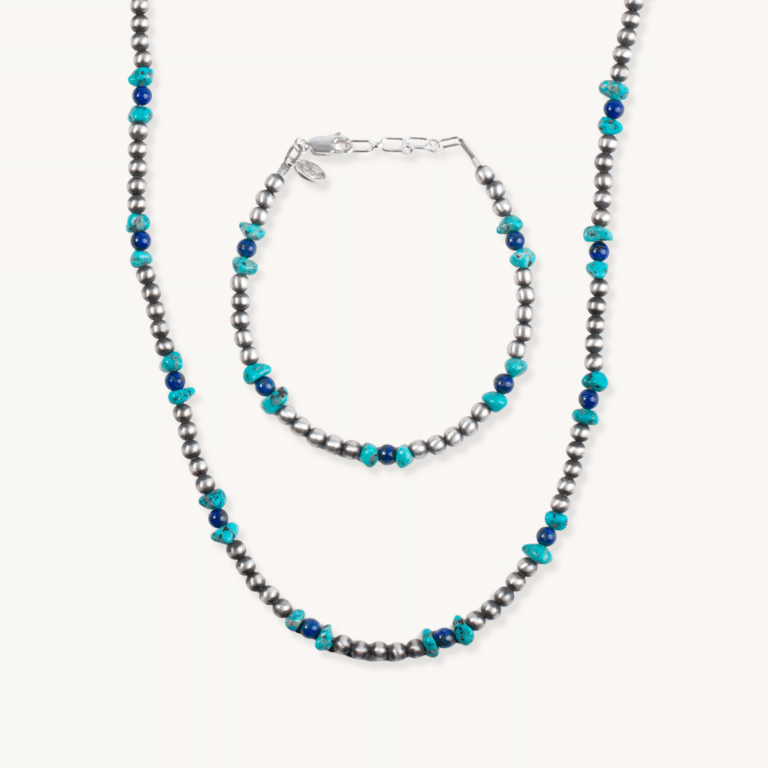Timeless and Ever-New — The Five Kings of the Gemstone World
Insider Tips on Selecting and Valuing Gemstones: Diamond, Emerald, Sapphire, Ruby, Jade
For a long time, diamonds have been the best tokens of commitment between men and women in the world. Their unmatched brilliance and hardness are symbols of unwavering loyalty in love.

Πίνακας περιεχομένων
Section ⅠDiamond
For a long time, diamonds have been the best tokens of commitment between men and women in the world. Their unmatched brilliance and hardness are symbols of unwavering loyalty in love. According to statistics from De Beers, consumers in China rank eleventh in the world in total spending on diamond jewelry, indicating that people’s affection for diamonds is certainly on par with that of Europe, America, and other countries.
Do you remember the famous De Beers “A Diamond is Forever” television commercial? A man is sitting in a salon getting a haircut when a girl wearing a diamond pendant walks by outside. The diamond’s light penetrates the glass and catches the man’s eye, causing him to turn and look out the window, resulting in a chunk of hair being cut off. Thanks to the influence of De Beers’ advertisements and celebrity endorsements, many people view owning a beautiful diamond as a goal and affirmation of their hard work.
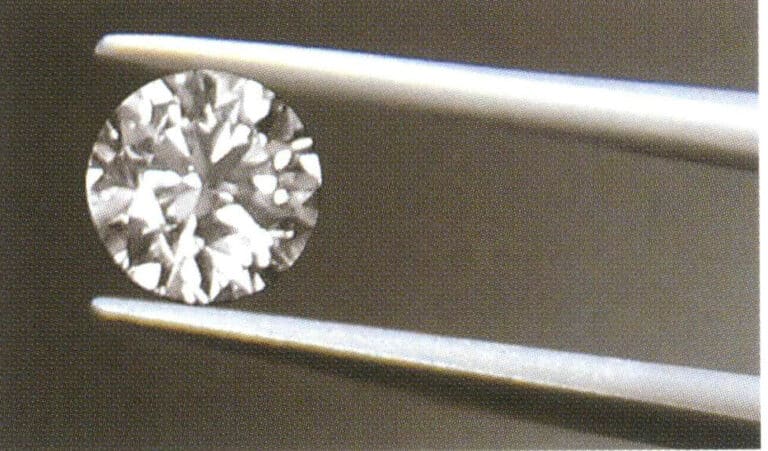
| Σύνθεση | Σύστημα κρυστάλλων | Σκληρότητα | Ειδικό βάρος | Δείκτης διάθλασης | Χρώμα | Διάσπαση | Θραύση |
|---|---|---|---|---|---|---|---|
| C | Ισομετρικό κρυσταλλικό σύστημα | 10 | 3.52 | 2.42 | Pale yellow or colorless, light green, light brown and slightly reddish, blue, with black, but darker colored diamonds are less common. Generally speaking, with the exception of White diamonds are generally slightly yellowish, except for white diamonds from the United States. | Perfectly octahedral solids | Σε σχήμα κοχυλιού |
For many people, their first diamond is often a wedding ring, bride and groom use diamonds to witness the steadfastness and longevity of love. With the intensification and transparency of diamond competition, unless purchasing a well-known brand, diamond prices are gradually becoming more accessible. For a 0.3-carat six-prong diamond ring most commonly chosen by newlyweds, the same quality level (E, VVS) with a GIA certificate can be purchased online for US$875-1031). At the same time, in silver jewelry shops or jewelry stores, the price is about US$1094-1563. If it is a well-known brand , it is priced at around US$1563-2189, while international brands charge between US$3127-9381. Consumers can choose according to their purchasing habits and brand recognition.
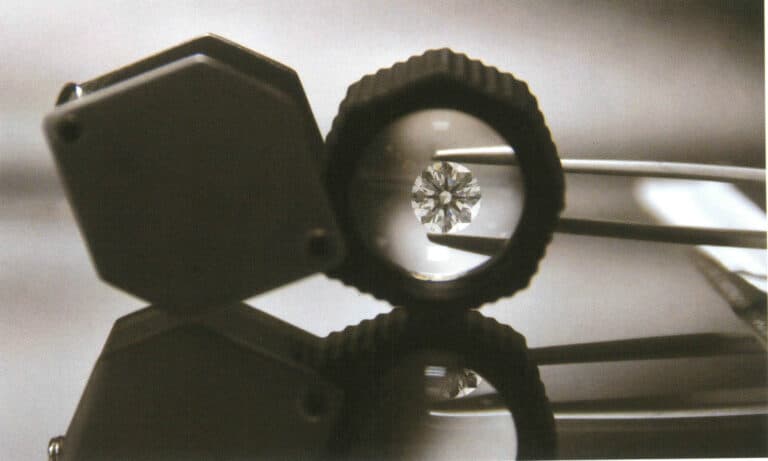
1. A simple classification of diamond color grades
| Color grade | Appearance of loose diamonds |
|---|---|
| D | Colorless and extremely transparent (very bright), extremely rare |
| E | Colorless and transparent (bright) |
| F | White and transparent, the slanted edge of the tabletop has a slight yellow tint. |
| G | From the front, the tabletop appears white, but when viewed at an angle, it has a slight yellowish tint. |
| H | From the front, the tabletop has a slight yellow tint. |
| I | From the front, anyone untrained can see a slight yellow tint on the tabletop. |
| J | From the front, the yellow tint on the tabletop is very clear |
| K | Looking at the surface from the front, it has a slight brownish tint in addition to yellow. |
| L, M | The brown color is deeper than K. |
| N ~ Z | Even without training, it is easy to see that it is obviously yellow. |
Note: If a diamond’s color grade exceeds Z, it is considered a fancy yellow diamond. Not everyone can easily judge a diamond’s color; to make an accurate judgment, one must first receive professional training and require professional lighting and color comparison stones for accurate comparison.
2. Diamond Clarity Grading
According to GIA, diamond inclusions can be classified into the following grades:
| Clarity Grade | Χαρακτηριστικά |
|---|---|
| FL (Flawless) | No inclusions or blemishes visible to the naked eye |
| IF (Internally Flawless) | The outer waist area has natural or excess facets, but it does not affect the diamond's inclusions grade. |
| VVS1, VVS2 (Very Slightly Included) | Flaws that are difficult for experts to find even under 10x magnification, usually white pinpoints. The difference between VVS1 and VVS2 lies in the quantity of flaws. This is already a very high grade. |
| VS1, VS2 (Slightly Included) | Under a 10x magnifying glass, it is generally difficult for an average person to find small flaws. Flaws cannot be on the table. They are usually white pinpoints or small cracks and inclusions, with the difference between VS1 and VS2 being the quantity of flaws. Grades above VS have investment, value retention, and aesthetic utility. |
| SI1, SI2 (minor flaws) | Flaws are clearly visible under a 10x magnifying glass. Flaws may be on the table. They are usually white pinpoints, cloud-like inclusions, small cracks, and small black inclusions, with the difference between SI1 and SI2 being the quantity and distribution of flaws. |
| I1, I2, I3 (flaw grades) | Flaws visible to the naked eye. They are usually cloud-like inclusions, cracks occupying 1/3-1/2 of the diameter, and black inclusions, with the difference between I1, I2, and I3 being the quantity and distribution of flaws. They severely affect the diamond's luster and transparency, making them unsuitable as gemstones. |
Note: FL stands for Flawless. IF refers to Internally Flawless. VVS means Very, Very Slightly Included. VS is Very Slightly Included. SI is Slightly Included. I am Imperfect.
3. How to choose a wedding ring?
What is the budget?
Choosing a diamond, like other wedding expenses such as taking photos, ordering cakes, and honeymoon trips, should start with a budget. For diamonds, it is recommended to estimate around US$781-1094, and US$1563-2189 for a 0.5-carat diamond. However, for a 1-carat diamond, uncertified diamond in China, with a color grade of about J-K and an inclusion grade of about VS, the market price is around US$4690-5628 (usually marked as (F, VVS) on Chinese certificates). The budget is about US$7818, and online searches can find diamonds with GIA certificates (E, VS2) or (F, VVS1) grades. If you want the (D, IF) color, which is the whitest and completely flawless, the quote for a 1-carat diamond is nearly US$25017. Diamond prices are calculated in USD and fluctuate due to international exchange rates. For friends with a tighter budget, if you only have US$ 312, how big of a diamond can you buy? You can still find a US$312 ring online, about 0.15 carats. What if the budget is only US$156? There are wedding diamond rings around 8-10 carats available in local jewelry stores. There are at least 20 styles available, regardless of style, gender, or ring size, and you can buy one for about US$156. If the budget is less than US$156, it is recommended to find a cubic zirconia (CZ) to wear, which costs around US$9-31 online, and later, when you earn money from work, you can buy a natural diamond to make up for it!
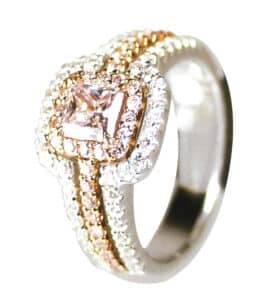
4. Where to buy?
Traditional Silver jewelry Shop
Most silver jewelry shops primarily sell gold jewelry, but they also offer crystals, pearls, rubies, sapphires, diamonds, jade, and other gemstones. Traditional silver jewelry shops generally provide services such as jewelry cleaning, ring size measurement, ring resizing, and ring plating, and they are often located near residential areas. Silver jewelry shops indeed have a significant advantage in terms of friendliness and convenience. Moreover, all silver jewelry shops must join a guild that values reputation, so purchasing diamond rings from a silver jewelry shop is relatively secure. If consumers choose to buy diamonds from a silver jewelry shop, it is best to understand the diamond market first; they can gather relevant information online to use as a reference for negotiation.
Department Store Diamond Counter
“Miss Li, this outfit makes you look ten years younger.” “Mr. Wang, you’ve been looking slimmer lately, just like Show Lo.” “Madam, you resemble Lin Chi-ling.” “Miss Chen, you look so elegant wearing that ring, just like a ‘Miss China.'” Hearing such compliments must surely make one feel elated; this is the selling point of the sales staff at department store counters. Buying diamond rings at the department store diamond counter is mainly about enjoying the esteemed atmosphere and the sense of luxury. Of course, accumulating reward points through card payments and installment plans is also an incentive. Furthermore, the diamond styles sold at department store counters are mostly innovative and trendy. However, department store counters have commission deductions, card processing fees, and tax issues, making it difficult for consumers to find reasonably priced GIA diamonds. Nevertheless, businesses often offer discounts during department store anniversaries to boost sales.
Brand Jewelry Store
Most brand jewelry stores are elegantly and luxuriously decorated, creating a noble and grand atmosphere that attracts consumers to shop. The crowd mainly consists of mid to high-level executives, socialites, wealthy women, civil servants, or discerning consumers. Branded jewelry pays excellent attention to craftsmanship and does not skimp on the cutting of diamonds. You can find it here, whether trendy or vintage, minimalist or luxurious design style. Viewing jewelry in a brand jewelry store also allows you to enjoy Very Important Person box service, with dedicated staff providing introductions and explanations, snacks, and coffee; accompanying children will receive care and attention like little princes and princesses. Here, the focus is not on price, but on whether the quality is satisfactory, the style is liked, and how it looks when worn. Under the brand’s influence, diamonds of the same quality may cost several times more. You will be disappointed if you want bargains in a brand jewelry store.
What is a cubic zirconia?
The chemical composition of a cubic zirconia is ZrO2, with a specific gravity of 5.9 and a hardness of 8.5. It is a type of synthetic gemstone, and due to its low price, it is the most common imitation diamond on the market. There are no minerals with the composition of ZrO2 on Earth; they are artificially created.
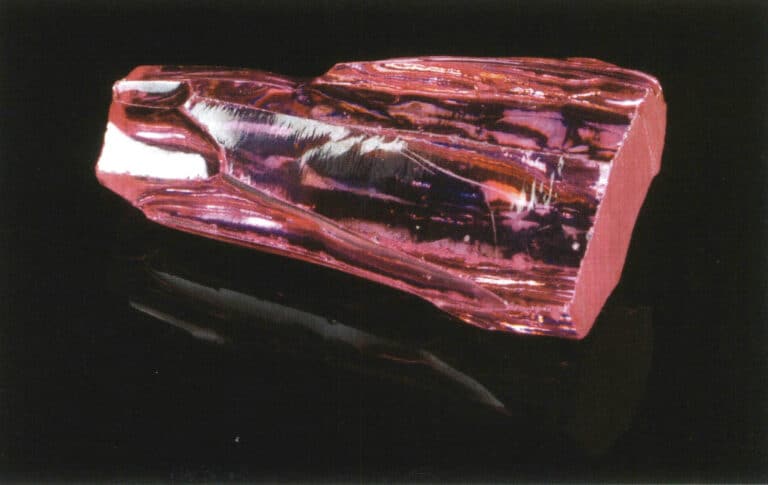
Online auction diamond chain wholesale
Since 1994, the diamond trade has undergone significant changes. The traditional retail method has shifted to online auction wholesale sales, and most online auction sellers have physical stores where consumers can personally select their diamonds. This sales method has captured about 60-70% of young people purchasing diamond wedding rings. Generally speaking, online auction operators buy diamonds from outside the China and sell them directly to consumers through online exposure, without going through the distribution system in the middle, eliminating the profits of the dealers, and then they can directly return to the consumers. Furthermore, online auctioneers categorize and label diamond color, inclusions, cut, fluorescence level, etc., and list them according to diamond weight, allowing consumers to quickly choose based on their budget. When consumers buy diamonds online, comparing prices is beneficial. After deciding on the diamond or ring style they want to purchase, they can visit the seller’s physical store to inspect and choose without worrying about overpaying, getting a lower grade, buying counterfeit goods, or being swapped. On-site, they can use a microscope to observe the GIA laser inscription on the diamond’s girdle and check its authenticity on the GIA certification website.

5. TV shopping channel
“Mr. Xu, please! Today the diamond is being upgraded! Originally F Color, but today we mistakenly assessed it and directly upgraded it to E Color, allowing you to earn twenty thousand right away!” (Applause) “Now the lines are full; if the audience friends can’t get through, old customers can directly call the voice hotline. We will also give you a pair of Eight Hearts and Eight Arrows diamond earrings if you order today!” This type of dialogue is commonly heard when tuning into a TV shopping channel. TV shopping channels selling diamonds or gemstones usually engage viewers with humorous dialogues between manufacturers and presenters, professional introductions, and beautiful model displays, emphasizing a seven or ten-day appreciation period to stimulate purchasing impulses. When shopping on TV, consumers can enjoy credit card payments, interest-free installments, and free returns.
Everyone wants to know whether those shopping experts tell the truth. Is it the cheapest to buy diamonds on the shopping channel? The color and quality of the diamond’s cut and the number of inclusions are closely related to the price; each certification’s content and meaning have some clues to follow. When consumers buy diamonds on the shopping channel if they feel the price is acceptable and like the gemstone style, that’s enough. If they are still not at ease, you can use the seven-day (or ten-day) appreciation period to consult friends who understand diamonds and ask which manufacturers have good quality and which have average quality. As for whether the price is the cheapest and whether it is really, as the shopping channel jewelry manufacturers say, selling at a loss? Consumers can use their wisdom to judge.
Here’s a tip for finding bargains: Only some manufacturers collaborating with TV shopping channels can clear all their stock in every show. After the show period, many manufacturers likely have some inventory left, so it’s worth inquiring; they would be happy to exchange stock for cash.
6. Where to find a goldsmith?
If you have seen the advertisements for PX Mart, you know that money-saving experts across China always find ways to save every last drop; the late business god Wang once said that doing business is not about how much you earn but how much you can save. If you bid for or purchase diamond loose stones online, besides asking the original company to help you process it (which may be a bit more expensive), you can also commission a goldsmith to set it into a diamond ring. If you already know how to work with gold, congratulations, you are the biggest saver; if you have relatives or friends who are setters, you can save quite a bit. Additionally, if you know a casting workshop, you can look for ready-made ring mountings or search online for excellent goldsmiths. Finding a goldsmith to set diamonds yourself can save your budget, but there are also several drawbacks: first, the finished product may not be satisfactory and may require constant modifications; second, you bear the risk of insufficient K gold content; third, the final price may differ from the initial estimate. It would help if you asked the goldsmith for a quote in advance, with the gold price based on the day of the transaction and the costs for labor and side diamonds written down; fourth, delivery times may be delayed. Many goldsmiths have a lot of cases on hand, and if it’s wedding season, sometimes the delivery date may be postponed.
A reminder to everyone: buying diamonds and finding a setter yourself takes a lot of time, and you need to have some professional knowledge and communicate fully with the setter. If you are very busy with work, this method may not be worth considering.
7. Diamond Trivia
Is a diamond with a GIA certificate necessarily better?
Most consumers are most afraid of buying fake diamonds, followed by buying them at too high a price, and only then are they concerned about buying diamonds of lower quality. Therefore, sellers capitalize on consumers’ mindsets by promoting that diamonds with GIA certificates are more reliable, reducing consumers’ doubts. But is this true? Diamonds of the same grade do not differ much in price, regardless of whether they have a GIA certificate. In the past, sellers would send high-quality, high-grade diamonds for certification to obtain a GIA certificate, while diamonds that were yellow or had many inclusions would not be sent for certification. This led many people to believe that diamonds with GIA certificates are better.
However, sellers now send diamonds with poor cut proportions for GIA certification. It’s possible that the cut quality of this diamond is only rated as Good, and the diamond’s girdle may be very thick and leak light while intentionally keeping the weight precisely at 1.00 carat. the Good cut grade, there are two higher grades: Very Good and Excellent. Therefore, as long as you are clear about your needs, whether to buy a diamond with a GIA certificate is up to you. However, diamonds with higher grades and more perfect cut proportions usually sell better if they have a GIA certificate. Additionally, GIA old certificates issued before 2007 must indicate the cut proportions’ quality. If you acquire diamonds with these old certificates, pay special attention to the quality of the diamond’s cut proportions (table 52%-62%, depth 57%-63% is better).
When purchasing diamonds with certificates, special attention should be paid to the weight of the diamond indicated on the certificate. If the diamond is precisely 1.00 carat, it is best not to buy it. If you want to buy it, you can negotiate a good discount because the price difference is significant if the diamond does not reach 1 carat. If the weight is exactly 1.00 carat, it must not have any chips or missing points. If possible, choosing diamonds weighing 1.03 carats or more is better.
Additionally, also look at the certificate labeled cut a few excellent. If the Cut Grade, Polish, and Symmetry are all Excellent, and the Fluorescence is None, it indicates that the quality of the diamond is excellent, and the price will be relatively high.
Does the shape of the diamond affect the price?
The most common diamond cut is the Round Brilliant Cut, which divides the diamond’s girdle into two parts: the upper part is called the crown, and the lower part is called the pavilion, with 57 facets. All diamond cuts are referred to as fancy cuts. As design trends change, designers require diamonds in different shapes to complement the primary gemstones, leading to various fancy cuts. Common shapes include heart, pear, marquise, princess, emerald, oval, triangle, and radiant. The shape of the diamond is primarily determined by the original stone’s shape, aiming to cut it into various shapes while minimizing weight loss and maximizing value. Therefore, round brilliant diamonds are usually the most expensive, and other shapes do not increase in price due to unique cuts. Many sellers tell consumers this is a unique cut, relatively rare, so an additional price of 10%-30% is needed according to the price list. The market is quite the opposite; fancy-cut diamonds are priced much lower than round brilliant diamonds, leaving room for negotiation.

Is the diamond with eight hearts and eight arrows (Cupid cut) necessarily better?
Visiting various jewelry stores, I noticed that almost all shops emphasize that their diamonds have eight hearts and eight arrows. What are eight hearts and eight arrows? This is a visual effect created by the “Cupid cut.” When we use a loupe to observe the diamond with the table facing up and our eyes close to the loupe, we can see eight arrows; when we turn the diamond upside down with the point facing up, we can see eight hearts. This kind of cut first originated from Japan, they call it Happy Diamond, is the industry in response to the wedding market and launched products, and in the opening of the certificate is attached to the eight hearts and eight arrows of the photo, like the god of love, Cupid’s arrows hit the newlyweds, the two people heart to heart, loved by the newlyweds, and later on, this kind of cut is slowly spread to the diamond market in China. Therefore, in the early days in China, there were no diamonds with the “Hearts and Arrows” cut, and businesses would recut them to achieve this. Are diamonds with the “Hearts and Arrows” cut better? To have the “Hearts and Arrows” phenomenon, diamonds must have good symmetry; each tiny facet on the table must be symmetrical up and down, left and right; the table and the pointed bottom must not be offset, which is considered a good cutting. Almost any diamond with an Excellent cut has the “Hearts and Arrows” pattern, giving consumers great peace of mind.
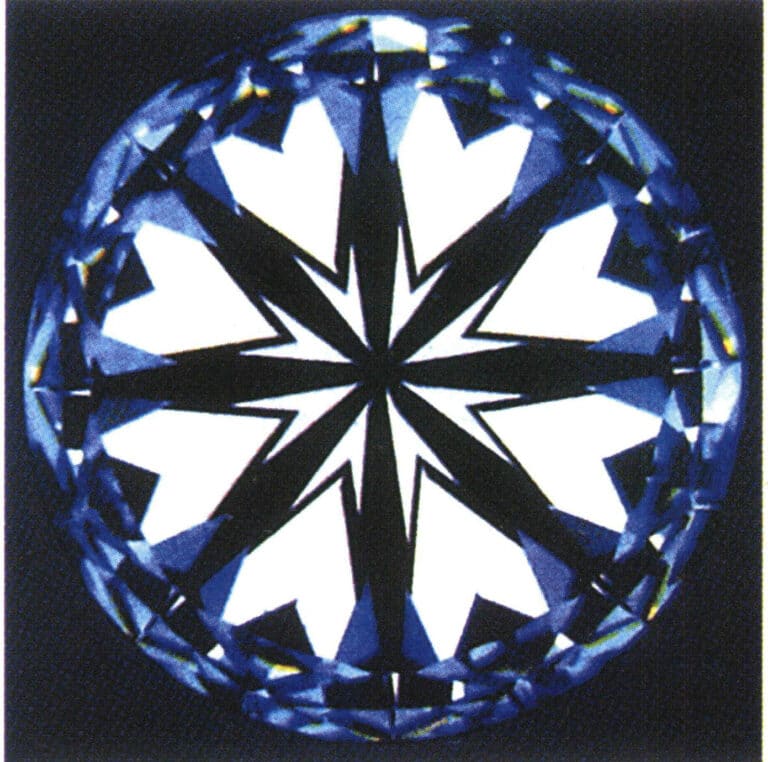
Eight hearts

Eight arrows
What is Moissanite?
Early consumers were most afraid of buying fake diamonds because, in the 1970s, a counterfeit diamond called “the Soviet diamond” appeared on the market.
Soviet diamonds are not diamonds; their composition is different from that of diamonds, and their physical and chemical properties are also different. They are not synthetic gems but artificial gems that look like diamonds. When the technology for making Soviet diamonds was first developed, a 1-carat Cubic Zirconia could sell for US$31-62. At the same time, the monthly salary of civil servants at that time was only US$187-218, which was about 1/4 of a month’s salary. If we consider the current monthly salary of civil servants to be US$1250, that would be equivalent to US$312. A 1-carat fake diamond costing US$312 is super expensive! However, now a 1-carat “Hearts and Arrows” Cubic Zirconia can be bought for about US$0.9-1.56.
Since 1998, another type of fake diamond, Moissanite (composed of SiC), has appeared on the market to replace the Soviet counterfeit diamonds. Hundreds of pawn shops across China were deceived in just one month, with fraudulent amounts exceeding ten million. In the early years, diamond authenticity tests used testing machines, and Moissanite looked like a diamond and had a fast thermal conductivity, allowing it to pass the tests. However, Chinese dealers now refer to Moissanite not as a diamond but as “Moissanite Gem.” The current market price for Moissanite is about US$5-15 per carat (with a diameter of about 6.5 mm). Moissanite tends to have a yellowish color, around J ~K color (if technology improves, it will become whiter); it has notable needle-like inclusions; When viewed from above, you can see a doubling effect on the pavilion’s facets; a loose stone can float in a liquid with a specific gravity of 3.32 (iodomethane), while a natural diamond will sink. A new type of diamond testing machine has been developed to distinguish between natural diamonds and Moissanite, and the loose stone must be cleaned before use to avoid misjudgment.
Differences between diamonds and several common diamond simulants
| Διαμάντι | Κυβικό ζιρκόνιο | Magic Star Stone | Strontium Titanate | Garnet-Aluminum Alloy | Συνθετικό ρουτίλιο | |
|---|---|---|---|---|---|---|
| Components | C | ZrO2 | SiC | SrTiO3 | Y3Al5O12 | TiO2 |
| Δείκτης διάθλασης | 2.42 | 2.15 | 2.65 ~ 2.69 | 2.41 | 1.83 | 2.60 ~ 2.90 |
| Birefringence | / | / | 0.04 | / | / | 0.29 |
| Διασπορά | 0.044 | 0.065 | 0.104 | 0.19 | 0.028 | 0.28 ~ 0.30 |
| Specific gravity | 3.52 | 5.40 | 3.22 | 5.13 | 4.57 | 4.22 |
| Σκληρότητα | 10 | 8.5 | 9.5 | 6 | 8.5 | 4.25 |
| oleophilicity | Ναι | Όχι | - | Όχι | Όχι | Όχι |
| Cleavage or Crack | Hair-like on the Waist | / | / | / | / | / |
| Συμπεριλήψεις | Mineral Crystals | / | Needle-like Objects | Bubble | / | Bubble |
Diamond Price List
The diamond market was first compiled by American diamond dealer Martin Rapaport, who collected retail prices of diamonds and created a table based on GIA grades. Currently, GIA diamond prices refer to this price list, which is updated every two weeks (China also considers fluctuations in the US dollar exchange rate). The diamond price list is based on weight, clarity, and color, but does not take into account the quality of the diamond’s cut, so there is usually room for discounts when selling. However, diamonds over 1 carat with three Excellent cuts and no fluorescence are rare, and most stores will mark them up for sale.
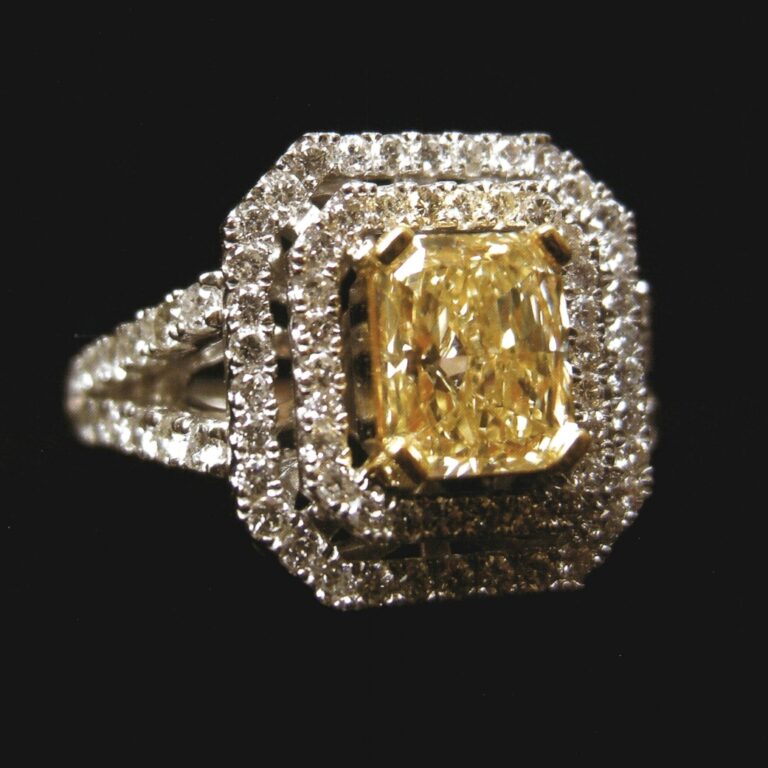
Should I prioritize diamond color or clarity?
Every time we have a diamond class, friends ask: “Teacher, when the budget is limited and it’s impossible to buy a perfect diamond, should we prioritize the diamond’s color or clarity?”
If the budget is US$6254, you can roughly choose a combination of color I or above and clarity VS2 or above, such as (I, VVS2) (quoted at 6,600 USD) or (H, VS1) (quoted at 7,000 USD). I would choose the (H, VS1) combination because I prefer diamonds that are a bit whiter, and no one will use a 10x magnifying glass to examine the ring on your hand, so a slightly lower clarity level is acceptable, however, color grade I can be visibly yellow to the naked eye, and even if the clarity level has flaws that experts do not easily see, it does not add much to the visual experience.
If the budget is US$9381, there are two options: (E, VS1) (quoted at 10,500 USD) and (G, VVS1) (quoted at 10,400 USD). Although both are slightly over budget, there can be flexible discounts on the cut grade from Very Good to Excellent. I would choose (E, VS1) for the same reason: its color is relatively white.
Of course, if you are particularly concerned about inclusions, you can choose (I, VVS2) or (G, VVS1).
Is investing in diamonds profitable?
Friends often ask me: “Mrs., will buying diamonds for investment make money?” or say: ” When you buy it, it’s very expensive, in a hurry to sell, buy US$ 4690 in diamonds. When taken to a pawn shop, only about US$1563-2189; how can that be profitable!” Honestly, anyone short on cash taking a 1-carat white diamond to a pawn shop with a Chinese certificate will likely get only about US$1563-2189.
The friends then say: “So doesn’t that mean it can’t be an investment? Didn’t the teacher say diamonds will be appreciated every year?” Please think about this: pawn shops buy back diamonds to make a profit and only pawn them if absolutely necessary. If a diamond worth US$4690 is used as collateral, no one would lend you US$4690, right? This is quite reasonable! Additionally, based on my observations, a 1-carat All perfect (D,IF) diamonds this decade has risen from more than US$12508 to nearly US$25017. In the future, barring any unforeseen circumstances, prices are expected to continue to rise. This means that diamonds purchased over a decade ago could yield a profit of over US$9381 at current market prices. Taking a 1-carat diamond as an example, to maintain value and appreciation while being easy to sell, I believe the color should be at least G or above, and inclusions should be at VS2 or above. Like investing in real estate, location matters; the better the grade of the diamond, the greater the appreciation.
Not only white diamonds, but the price increase of colored diamonds is also quite astonishing, with pink and blue diamonds being the rarest and experiencing the most significant price increases. The Fancy Light Pink diamond, favored by mature women, is quite rare, with a market price of 1 carat ranging from US$40653-46908, and there is still considerable room for price growth in the future. If you like yellow-colored diamonds, Fancy Intense or Fancy Vivid have more price appreciation; brown or coffee-colored diamonds are among the lower-priced colored diamonds, and you can buy them online for about US$938-1563, as for black diamonds, they were initially used for industrial purposes, but now most are used for design purposes, with a price of US$156-218 for 1 carat.
Purchase Proposal:
When investing in colored diamonds, they must have a GIA certificate, and you should carefully check the contents of the GIA certificate to see if the color is natural. Yellow-colored diamonds are best if they are Fancy Intense or Fancy Vivid, with those over 5 carats being rarer and those over 10 carats even rarer. Pink diamonds have become quite popular recently, and it’s best to choose those over 1 carat; the higher the Fancy Pink grade, the rarer it is. If it exceeds 5 carats, Fancy Light Pink is also acceptable. Blue-colored diamonds should also be over 1 carat, preferably Fancy Blue. The clarity of all colored diamonds should ideally be VS grade or above. In this M-shaped society, wealthy individuals are becoming increasingly picky about the quality of diamonds they purchase. Visiting Sotheby’s or Christie’s auctions of colored diamonds will help you understand how to invest in them.

“Cow dung” diamond?
Is it rediculous make diamonds from cow dung? Wouldn’t it smell terrible when worn? Not at all! ” “Cow dung” is a synthetic diamond developed by the world-renowned Prof. Hegaung Mao. He uses a natural diamond rough of good color and a thickness of 5 mm as a mother stone. Then, he grows the diamond layer by layer using high-purity methane (CH4, produced by cow dung or garbage) and hydrogen, nitrogen, and other gases under high pressure by microwaves to cause carbon molecules in the methane to build up on the diamond rough. This principle is known as “Chemical Vapor Deposition” (CVD). The process seems simple, but making diamonds proliferate takes work. Diamonds produced by the CVD method generally have brown or yellow hues, with poor color grades, and it isn’t easy to grow them to 3 carats. In particular, diamonds made by the CVD method are generally brownish or yellowish, with poor color grades, and are challenging to grow to 3 carats. However, in May 2005, Mao Heguang and others in Japan held the 10th “International Conference on New Diamond Technology,” which showed 10-carat, transparent colorless CVD diamonds, a worldwide sensation. Then, at the United States Practical Diamond Conference, “large diamonds are produced very fast” (Very Large Diamonds Produced Very Fast) was published under the title “CVD diamonds are produced very fast.” Then, at the American Practical Diamond Conference, it was published under “Very Large Diamonds Produced Very Fast,” which immediately attracted significant media coverage from all sides, a big breakthrough for CVD diamonds. Speaking of which, are you worried that diamonds will crash? Do you want to get rid of your diamonds quickly? Please rest assured that with the GIA and other appraisal organizations, you can still distinguish between natural and synthetic diamonds, which will not affect consumers’ rights.
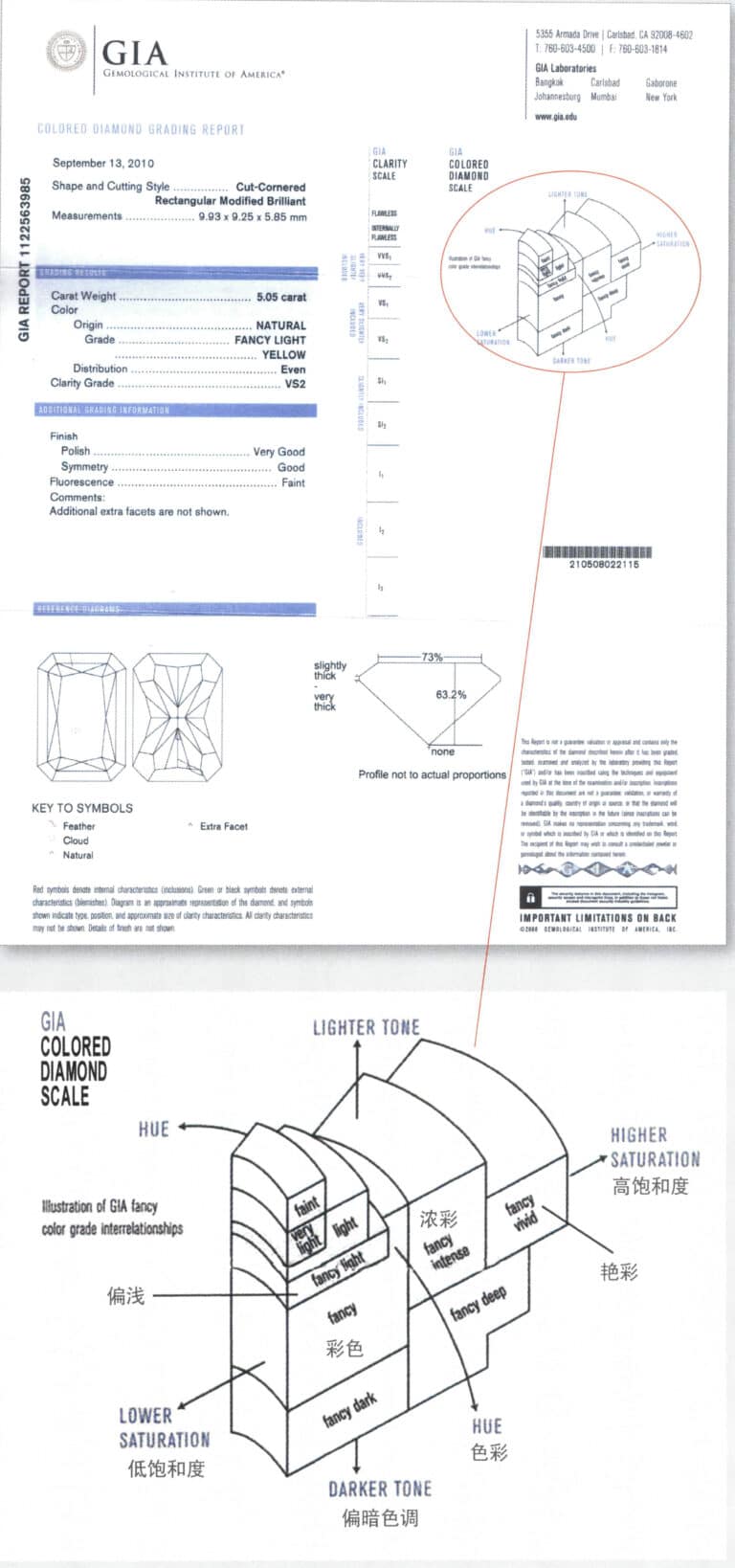
What are the other internationally recognized diamond appraisal organizations?
Besides GIA, there are also AGS (American Gemological Institute), HRD (High Diamond Conference), SSEF (Swiss Gemological Association), and EGL (European Gemological Laboratory). These are all common and credible appraisal companies internationally. Since most jewelry manufacturers use GIA certificates, consumers are unfamiliar with appraisal centers other than GIA.

Section II Beryl
Green Beryl is a silicate mineral that produces many different colored gemstones due to the varying trace elements present during its formation, such as Emerald in vivid green, Aquamarine)in light blue or blue-green, Morganite in pink, and golden beryl (Gold Beryl). It is worth noting that red beryl (Red Beryl) is extremely rare, found in the Wahwah Mountains in western Utah, USA, and due to its limited production, it is not inexpensive. Below are introductions to the four major stars of the beryl family.
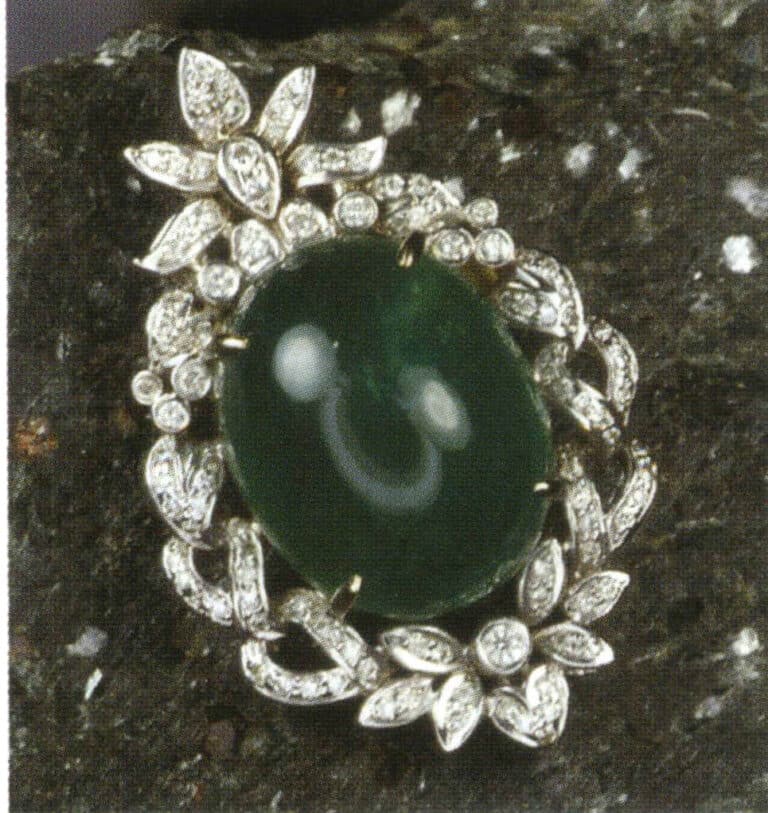
| Σύνθεση | Σύστημα κρυστάλλων | Σκληρότητα | Ειδικό βάρος | Δείκτης διάθλασης | Χρώμα | Διάσπαση | Θραύση |
|---|---|---|---|---|---|---|---|
| Να είστε3Al2 (Si6O18) | Εξαγωνικό κρυσταλλικό σύστημα | 7.5 ~ 8 | 2.67 ~ 2.78 | 1.566 ~ 1.600 | Πράσινο | Developed | Σε σχήμα κοχυλιού |
1. Emerald (Green Gemstone)
For a long time, Emerald has symbolized faith and mercy and is also synonymous with nobility and grandeur. Therefore, throughout history and across cultures, there are many legends about emeralds: It is said that if an emerald changes color, it means that the lover is unchaste in love; some say that emeralds have the function of maintaining eye health, others say they can enhance memory and intelligence, and even more believe they can help predict the future. In the West, emeralds are equally enchanting; historical records indicate that as early as six thousand years ago, the ancient Babylonian Empire used emeralds as sacred offerings to worship the goddess. They also believed that a man wearing an emerald could bring him more wealth; if a pregnant woman wore an emerald, she would have a smooth and safe delivery. Regardless of the truth of these legends, it is not difficult to understand that the name “emerald,” which sounds so reverent, indeed has extraordinary value.
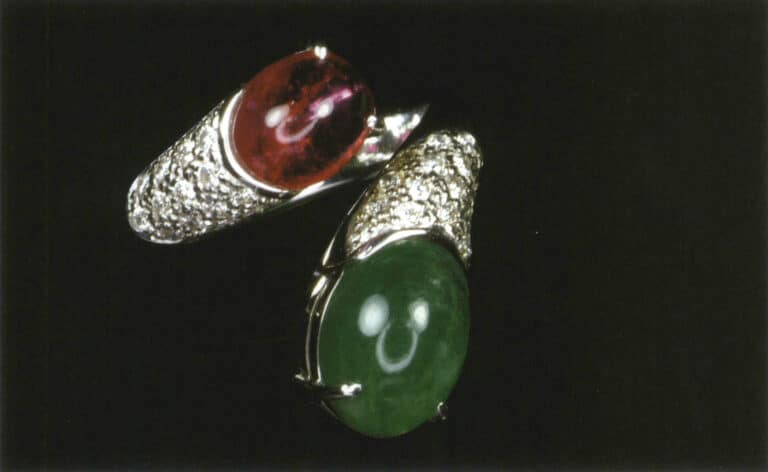
How to choose an emerald?
The best quality emeralds come from Colombia. Generally speaking, a high-quality emerald can reach a market price of 10,000 USD per carat, but I suggest that a beginner’s option is about 1 carat emerald for US$312-1563.
Since the bottom of the emerald is very shallow, with a low refractive index and little fire, the most important factors are color and clarity. Therefore, when selecting an emerald, first look at the color; it should be deep, rich, and slightly bluish. Second, check for inclusions; the cleaner, the better. Emeralds usually have some inclusions, and finding a clean one is quite tricky. When you see a clean emerald that is green with a hint of blue, the price can be shockingly high; a 1-carat stone is not something you can buy for just a few thousands of dollars. Such high-quality stones often appear at Sotheby’s and Christie’s auctions. If you see one at a roadside stall, you can be 100% certain that it is fake. If you are starting and want to own a 1-carat emerald without spending much money, I suggest you look online; usually, a 1-carat Zambian cabochon emerald is priced around US$31-62.
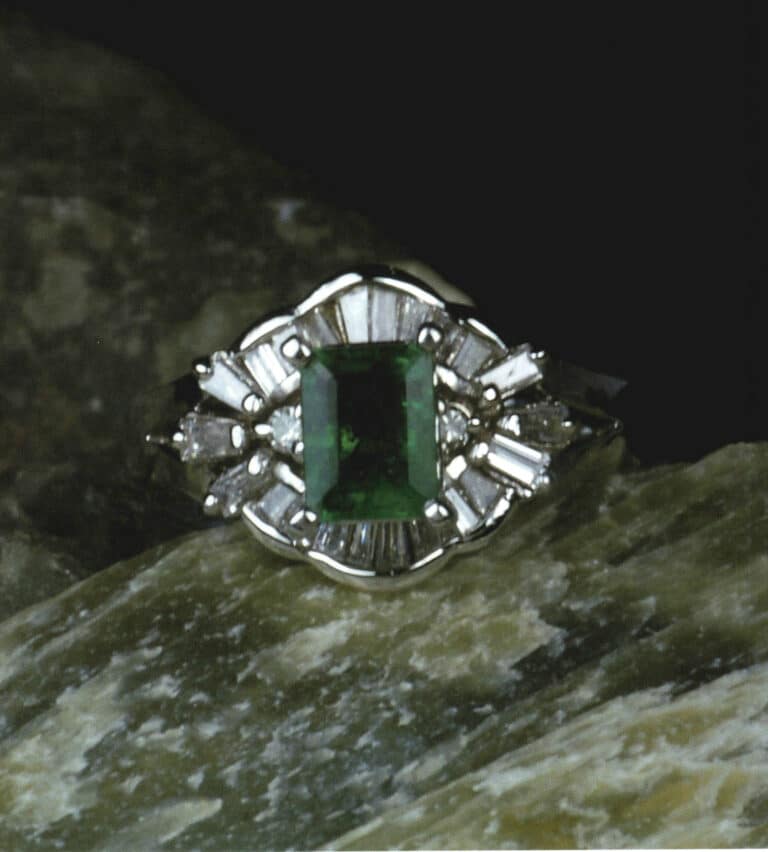
Colombian Emerald Ring

Zambian emerald gem Pendant.
There is a significant price difference between cabochon and faceted stones.
Higher quality emeralds are usually cut into square shapes (emerald cut), occasionally in teardrop shapes, while those with more inclusions appear in cabochon form. Typically, square Colombian emeralds are found under 5 carats, 5-10 carats are rare, and 10-20 carats are even more uncommon; anything over 20 carats is considered collector’s grade. As for Colombian cabochon emeralds, they generally weigh a bit more. I once saw a light green 100-carat Colombian emerald in Bangkok, which sold for US$375 per carat. Although larger gemstones are rarer and theoretically more expensive, there is a significant price difference between faceted and cabochon Colombian emeralds. For example, a 5-carat faceted Colombian emerald costs US$ 1563 per carat, while a 5-carat cabochon Colombian emerald costs US$312.
Do all emeralds have oil treatment?
Almost all emeralds that have been soaked in white oil fill the stone’s texture, making their appearance more beautiful. This is an accepted treatment method, as is the case with women buying skincare products to whiten their skin. On many domestic and international certificates, emeralds soaked in white oil are still labeled as “natural” emeralds. GRS certificates will specifically note the soaking in white oil. However, if they have been soaked in green oil, they cannot be considered natural emeralds and will be marked as optimally treated, which consumers should pay special attention to.
Will I be able to buy synthetic (cultivated) emeralds?
A friend bought an emerald ring with a GIA certificate in Singapore, and only when he took it to my class for appraisal did I realize it was purchased in Singapore. I immediately knew it was a synthetic emerald because Singapore does not produce emeralds! Now, many businessman sell synthetic or artificially cultivated emeralds, and there is also research on this. Therefore, consumers should pay special attention to the content of the certificate when buying emeralds to avoid purchasing synthetic ones.
However, it does not mean you cannot buy synthetic emeralds; you should know whether you are getting a natural or synthetic emerald; just like when a doctor prescribes medication, you have the right to know what drugs are prescribed, their effects and any side effects.
Maintenance precautions
Although the hardness of emerald is high, its texture is relatively brittle and prone to chipping. When selecting a setter, special care should be taken to avoid breakage during the setting process. It is best to choose an experienced master (the cost of setting emeralds is higher for the same technique) or directly buy finished products to avoid risks. It is advisable to return to the jewelry store every six months to clean the ring mounting (it is recommended not to use ultrasonic cleaning) and perform maintenance. You can also use baby oil at home to maintain your emerald forever green.
2. Aquamarine
The color of aquamarine is apparent and clean, making it popular among young people, and its value also depends on the color. If it is a transparent colorless aquamarine, it can be bought for US$6-9; if it is light sea blue, it costs US$15-31 per carat; the more popular medium sea blue in the market costs US$78-93 per carat; as for deep-colored top-grade aquamarine, it is priced at US$218-250 per carat. Clean and bright deep blue aquamarine is most commonly found in sizes around 10-20 carats. In contrast, those over 20 carats are rare, and 30 ~ 50 carats are already considered scarce, with over 50 carats being extremely rare.
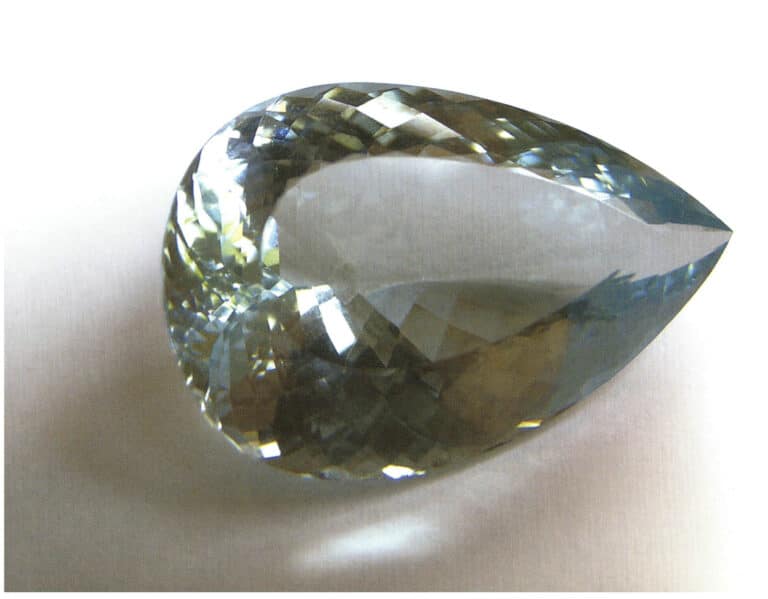
Ακουμαρίν

Aquamarine pendant
Color, firelight, cut, clarity are the most important factors in selecting aquamarine. More than 30 carats is quite rare.
3. Morganite
Young women have always favored pink gemstones, not to mention the Morganite, known as Baby Skin! With a color reminiscent of baby pink and rose-colored skin, this delicate and translucent hue is simply irresistible. In addition, several internationally renowned jewelry brands have made Morganite the central stone in their designs, significantly increasing its popularity; Chinese television shopping channels have also launched related products, allowing many homemakers to appreciate its beauty. Coupled with its moderate price range, the inquiry and acceptance of Morganite have significantly increased. Generally speaking, a Morganite of 1-10 carats with a light pink color costs only US$15-31 per carat; for those with pink or peach levels, a clean, perfectly cut Morganite can be purchased for US$31-62 per carat. Morganites over 30 carats are relatively rare, and the price per carat is around US$78-109 if the color is rich pink or peach.
Morganite is best to buy when the price is low.
Morganite mainly comes in light pink, peach pink, and pinkish purple colors and is one of the most favored pink gemstones among young professionals. Because it is much larger than pink tourmaline (which typically weighs about 1-3 carats), its production is also higher, yet its price is only 1/5 that of pink tourmaline. From my observation, consumers in China aged 40-50 prefer to choose Morganite around 10-20 carats for pendants and 5-10 carats for rings. From an investment perspective, it is advisable to select stones over 20 carats, with more profound and more saturated colors being better, and they should be internally clean with sparkling fire. Currently, Morganite is considered to be in a low price range, making it an excellent time to buy.
Why is it called the Morgan Stone?
The Morgan Stone is named in honor of the American banker John Pierpont Morgan (1837-1913). He collected a lot of precious stones in his life and finally donated them to the Smithsonian Museum in New York. It is said that his lifelong wish was to have a gemstone named after him. His good friend Dr. Kuntz, also the vice president of Tiffany & Co, discovered a new pink gemstone in California in 1911 and named the gemstone Morganite after him, which finally fulfilled his wish in Morgan’s later years.

Morgan Stone
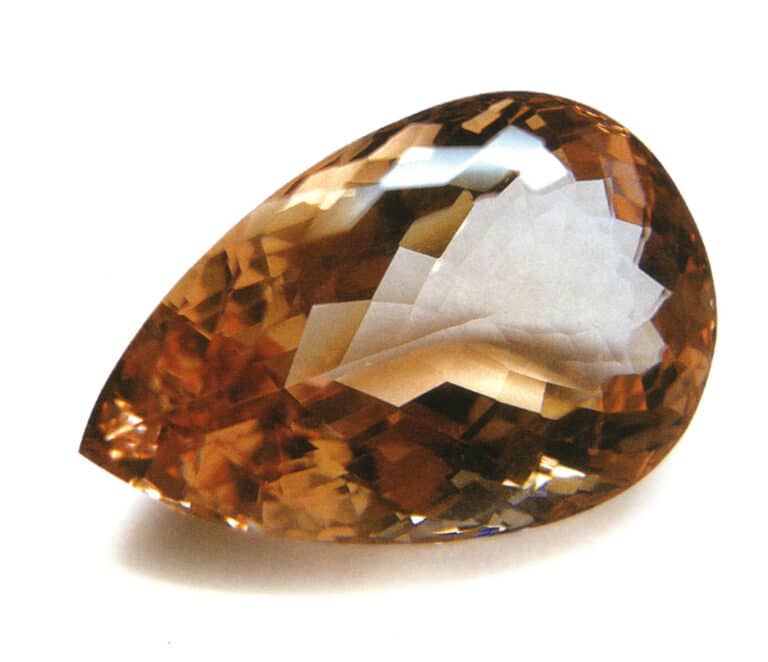
54 carat morganite
4. Gold Beryl
In China, yellow gemstones are primarily marketed to attract consumers with the promise of wealth. Among golden yellow gemstones, aside from yellow sapphires and Gold Beryl, golden beryl is the most notable, and its price per carat is more affordable. For sizes of 1-10 carats, the price is US$ 15-31 per carat; for sizes between 10 to 20 carats, the price is US$37-46 per carat; sizes over 20 carats are relatively rare, priced at US$62-93 per carat .
Designer’s favorite
Many designers like to use Gold Beryl as a stone, partly because its color is clean and bright and can be cut in various ways and partly because the price is relatively reasonable. The color of Gold Beryl is clear, and any impurities are easily noticeable, so perfect cutting and purity are the most basic requirements when selecting; its color ranges from deep to light, with golden yellow being the most popular and reasonably priced, so when purchasing, one should try to avoid choosing darker colors.

Section III Corundum
The most important members of the corundum family are rubies and sapphires. Other pink corundum are also very popular, and of course, we must also mention yellow sapphires, Padparadscha corundum, purple corundum, and star corundum, among other members of the corundum family.
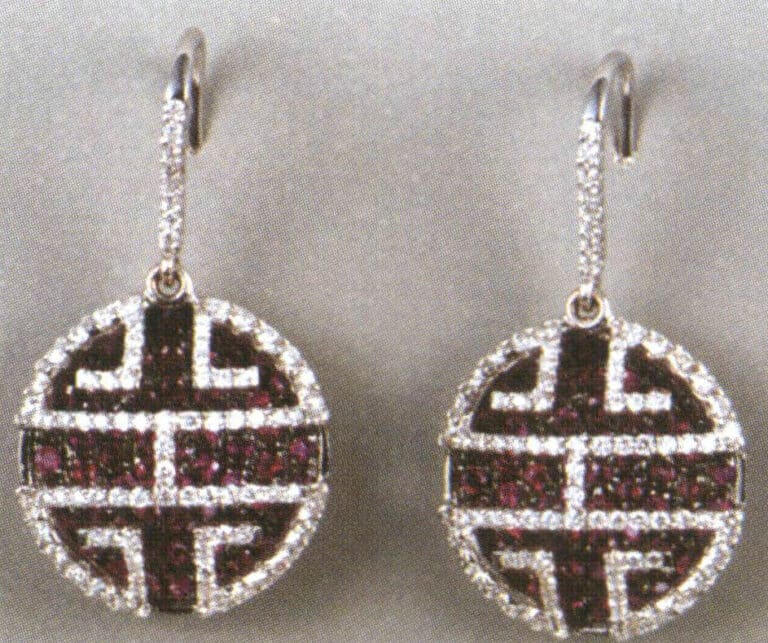
| Σύνθεση | Σύστημα κρυστάλλων | Σκληρότητα | Ειδικό βάρος | Δείκτης διάθλασης | Χρώμα | Διάσπαση | Θραύση |
|---|---|---|---|---|---|---|---|
| Al2O3 | Εξαγωνικό κρυσταλλικό σύστημα | 9 | 4.00 | 1.76 ~ 1.77 | Many colors, white, gray, yellow, brown, green, pink, dark red, blue | Differential | Κέλυφος που μοιάζει με κέλυφος |
1. Ruby
Legends about rubies are countless. For example, the Book of Job, Chapter 28, Verse 18 of the Old Testament mentions: “The value of wisdom is greater than rubies,” indicating how precious and valued rubies were at that time. In the ancient Western work “Lapidaie” (On Gems), it states: “The magnificent, clear, and noble ruby is the king of gems, the treasure among treasures, its merits surpass all other gems.” Additionally, it is said that those who wear rubies will enjoy good health, longevity, wealth, a happy love life, happiness, intelligence, and wisdom. Wearing a ruby ring on the left hand is believed to turn misfortune into good luck and can turn enemies into friends. The Burmese believe that rubies can protect people from harm. As early as the 13th century, rubies were used to treat issues related to excess bile and gastrointestinal bloating.
The elegantly luxurious ruby is often favored by women aged forty to fifty and above, so rubies are commonly used as gifts for Mother’s Day or retirement. When selecting a ruby, the most important factor is color; the more profound, brighter, and evener the color, the better. Next is the brilliance, followed by examining inclusions. Since clean rubies are rare, choosing a ruby is different from selecting a diamond; as long as impurities are not visible to the naked eye, they can be considered good quality and purchased. You will find some inclusions if you use a magnifying glass for a detailed inspection.
You’ll be shocked to hear the price
The price of rubies is largely related to their origin, with Burmese rubies being the most expensive. Most rubies seen on the market have been heated. heating is done to enhance the color, which does not damage the gem’s value. Taking high-grade Burmese rubies as an example, a 1-carat ruby costs around US$3120-4680; a 2-carat ruby costs about US$4680-7801; for 3-carat rubies, each carat costs between US$7801-9361; for 4-carat rubies, each carat costs US$10922-12482. As for 5-carat Burmese rubies, they are currently very hard to find, reportedly costing over US$93618 for one. However, Burmese rubies with less uniform color and more inclusions can be found for US$312-624 per carat. For African rubies of a certain carat size that have undergone glass filling optimization treatment, the whole stone can be purchased for about US$156.
Many may find it strange that rubies are becoming increasingly expensive and unattainable. This is because the high-end jewelry market is inherently closed, primarily consisting of collections from wealthy doctors, lawyers, financial executives, or entrepreneurs from around the world. Additionally, with the economic rise of mainland China and India, the number of collectors has increased, leading to a scarcity of high-quality pigeon’s blood rubies in the market. Among them, Burmese pigeon’s blood rubies over 4 carats have seen the largest price increase. Around 1996, a 4-carat Burmese pigeon’s blood ruby could be purchased for about US$31206, but now it costs at least US$40567-43688.
Copywrite @ Sobling.Jewelry - Κατασκευαστής προσαρμοσμένων κοσμημάτων, εργοστάσιο κοσμημάτων OEM και ODM
No-burn red gems, the new toy for the wealthy
The so-called “no heat” means it has not undergone heat treatment. This type of ruby is even rarer on the market, but there are many rich people around the world who want to collect them, so the price is naturally high. The same situation applies to untreated sapphires. I remind everyone to buy untreated rubies and sapphires, preferably those with international certification, for peace of mind. Generally speaking, the Cubelin certification authority is recognized for colored gemstones; another is the GRS certification. GRS classifies ruby colors into three categories: Red, Vivid Red, and Pigeon’s Blood. Different certification authorities may not agree on the color classification of the exact gemstone, so consumers must carefully review the certification details.
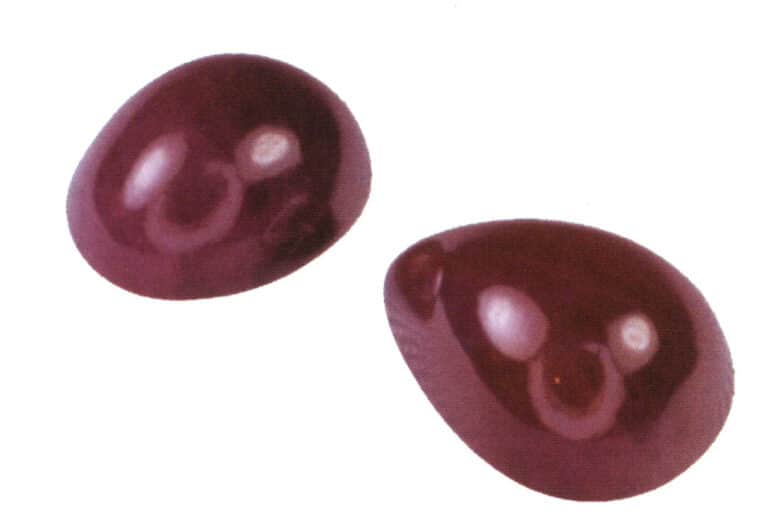
Ruby with cabochon face from Africa
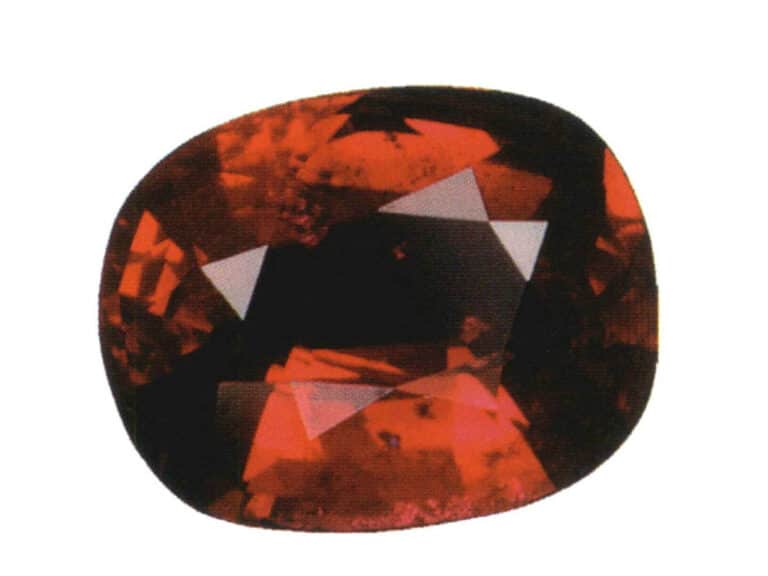
Ruby without heat
Emerging Rubies from Mozambique, Africa
Since 2007, high-quality rubies have been mined in Mozambique, Africa, with colors close to Burmese rubies, and their prices are similar to those of Burmese rubies, which are not cheap either. For example, a 2-carat ruby has a market price of US$6241-9361; a 3-carat ruby has a market price of US$15603-18723; and a 4-carat ruby is priced at US$40567-43688. After all, there are not many rubies with good color and brilliance, and more and more people are accepting high-quality rubies from Mozambique, which is considered positive news for the entire market.
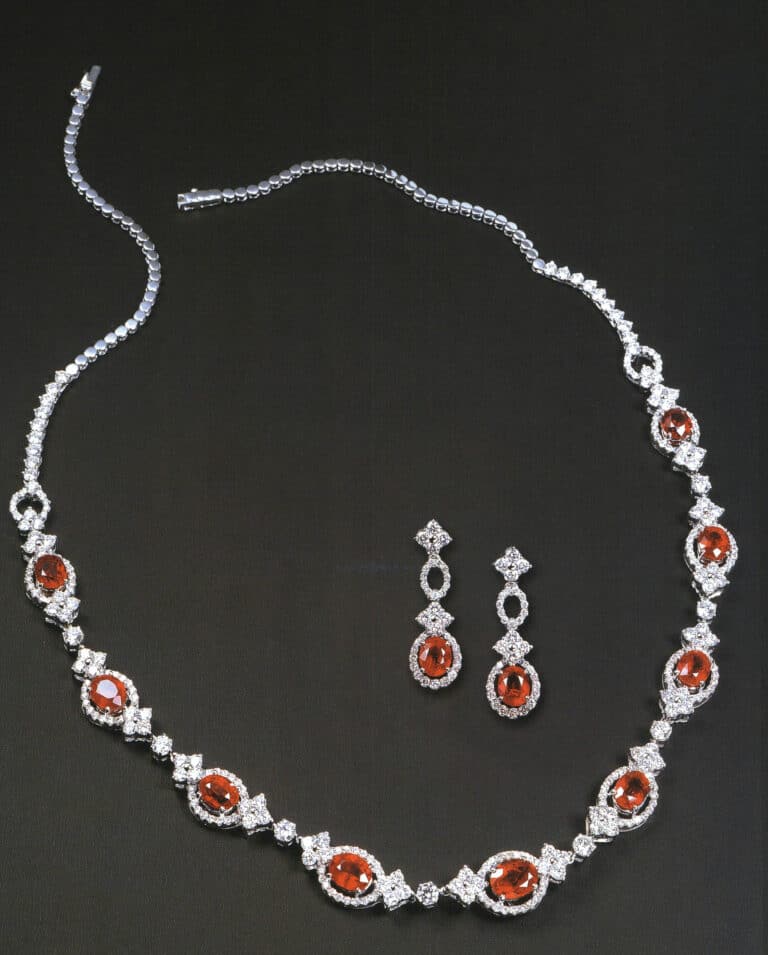
Burma pigeon blood red ruby set

Small Ruby Earrings
Can I buy African glass-filled rubies?
Around 2006, African glass-filled rubies began to flood the jewelry market, with sizes commonly ranging from 1- 20 carats. Due to the large quantity and diverse colors, some are very close to the color of Burmese rubies, which confuses buyers and makes it hard to distinguish between genuine and fake. When they first appeared, the prices of African glass- filled rubies in the market were very chaotic; some could be bought for a few hundred dollars per carat, while others were sold for several hundred dollars, and even bought them for thousands of dollars. The prices varied at different times, but there was a trend of price getting cheaper and cheaper. I believe that as long as they are not frequently exposed to hot environments that could cause the glass inside the ruby to melt, one can buy rubies of 3-5 carats, or even 10 carats, without spending a lot of money, which is also a good choice. Currently, on online auctions, naked stones of 1-5 carats are priced at US$6-15 per carat; for stones in the 5-10 carat range, the price is US$15-24 per carat; and for stones over 10 carats, the price is about US$24-31 per carat.

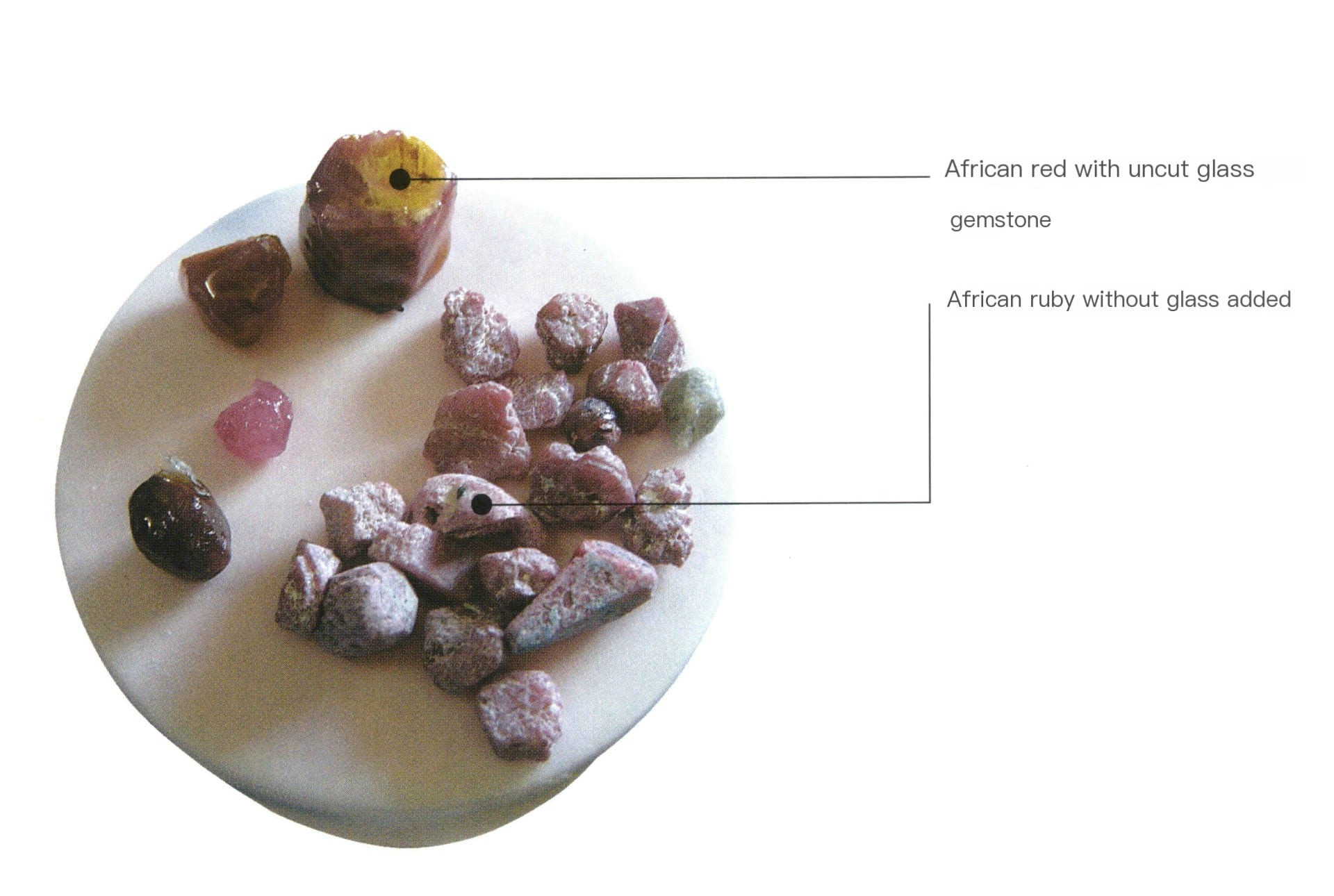
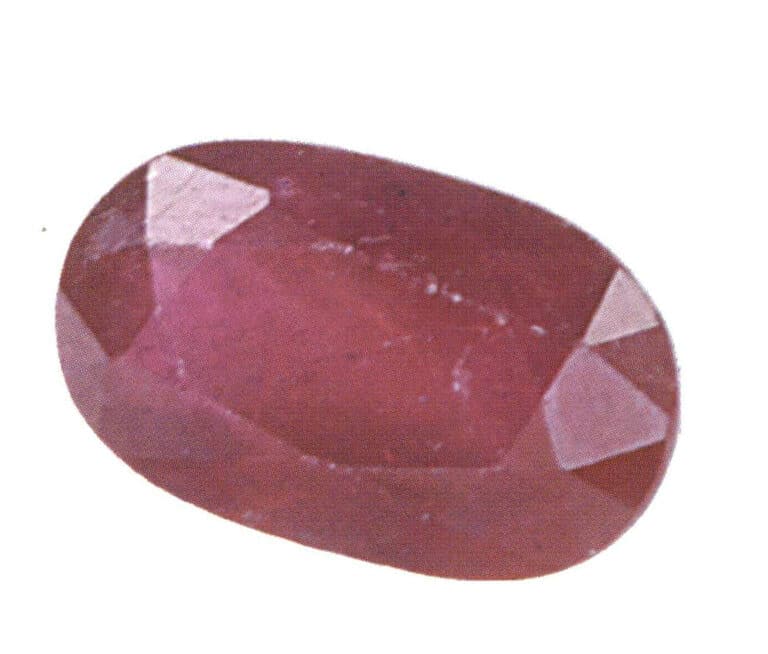
African red gemstone with glass, cut and polished, very similar in color to Burmese rubies, generally indistinguishable to the average consumer.
How can I buy good quality ruby at the source?
Many people who often travel to Southeast Asia (Cambodia, Vietnam, Thailand, Myanmar) will arrange an itinerary to see gemstones, whether rubies or sapphires. A 3-5 carat ruby or sapphire only costs US$93-156. They want to go sightseeing, and since it’s a gemstone-producing area, the prices are not high, so they bought several back to give to friends and family. Later, a friend told me: “Those rubies and sapphires are beautiful and very clean, really cheap. Jewelry stores sell them too expensively; one costs US$936-1560, but I bought them at the source for only US$93, and I made a profit!” Alas, those are synthetic rubies and sapphires; you can buy one for US$9-15! If you want to buy synthetic rubies and sapphires, you can find them in silver jewelry shops, jade markets, night markets, and online auctions; why bother flying to Southeast Asia? Sellers of synthetic rubies and sapphires often claim “high-tech cultivated corundum, with the same composition and physical properties as natural rubies,” but these are just words to deceive outsiders. I hope you won’t be a lamb to the slaughter anymore!
Most people may only buy precious stones like rubies and sapphires once in a lifetime, so it is recommended first to increase personal knowledge of gemology, look more, learn more, search for information online, understand the various treatments for gemstones, and then slowly make a purchase; do not act on impulse!
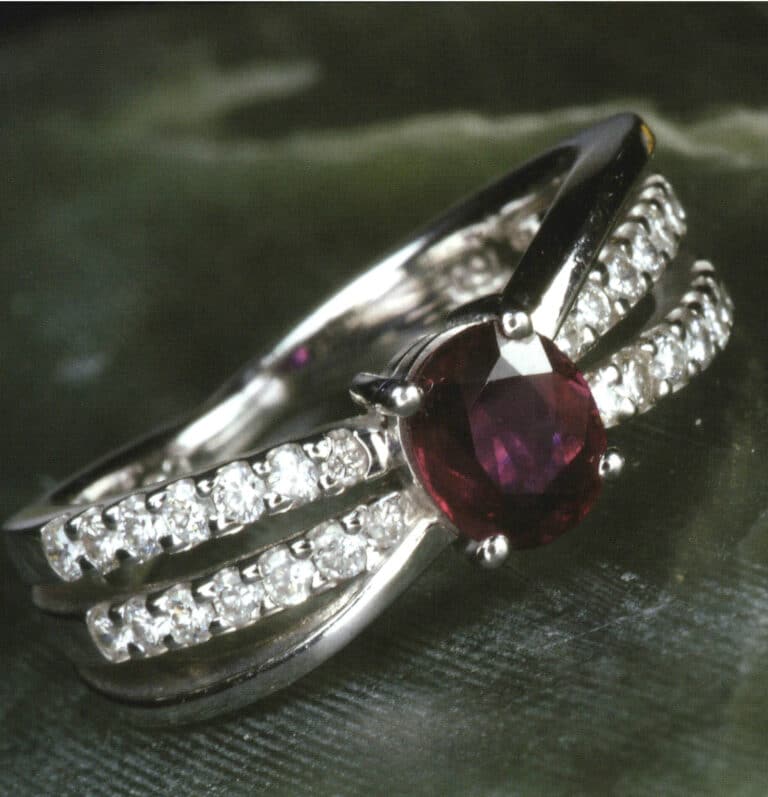
2. Sapphire
Like its sister “Ruby,” Sapphire also has many legendary stories. In Persia, locals believe that a giant sapphire supports the earth, and the light from the sapphire reflects the sky in blue. According to legend, sapphires also have healing properties and can be used to treat eye diseases. In ancient Eastern legends, sapphires can serve as guiding stones, and those who wear sapphires will not suffer harm from evil people; merchants who wear them can bring wealth; and ordinary people who hold a sapphire can have their wishes come true and succeed in everything they do.
Like rubies, the color and fire of sapphires are significant factors in their price; the more bottomless and uniform the color, the closer it is to royal blue, the better. However, sapphires have fewer inclusions than rubies, most of which are transparent gas bubbles or cracks caused by heat treatment. Transparent gas bubbles are more readily accepted, while cracks can affect the gem’s value.
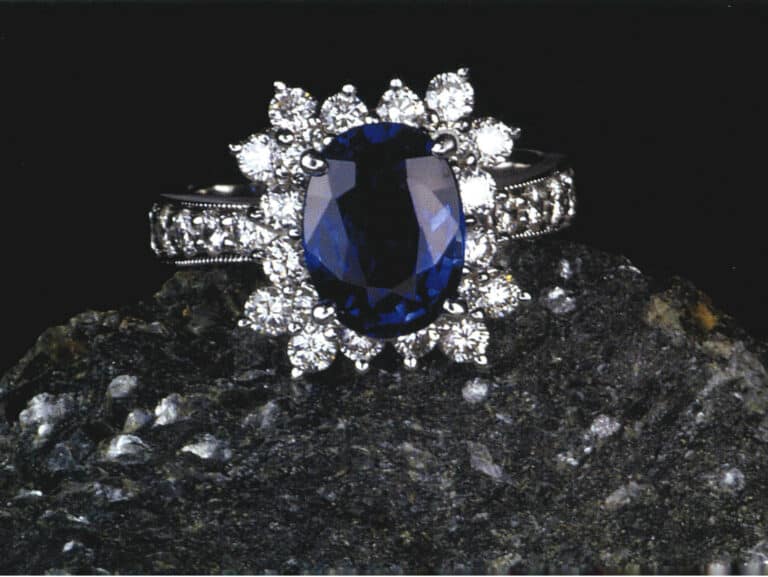
Sapphire market trends
In China, the most common sapphire is the Sri Lankan sapphire. High-quality Sri Lankan sapphires with good color, fire, and clarity are priced at US$312-624 for 1 carat; for 2 carats, each carat costs US$624-780; for 3 carats, each carat costs US$639-1092; for 5 carats, each carat costs US$1560-1872. However, sapphires with lighter colors, less fire, and more inclusions can also be found online for US$31-62 per carat. The above refers to heat-treated sapphires; the price will be higher if they are natural and untreated.
It is important to remind readers that the price difference between cabochon and faceted stones is vast when selecting rubies and sapphires. Generally, cabochon stones have more internal impurities and are priced at around 1/5 of faceted stones, but cabochon stones that are specially selected and polished are an exception.
The shape of sapphires relates little to their price, with oval being the most common. Other shapes include emerald, heart-shaped, marquise, and round diamond cut. Due to the high unit price, there are few fancy cuts that are presented in a more traditional appearance.
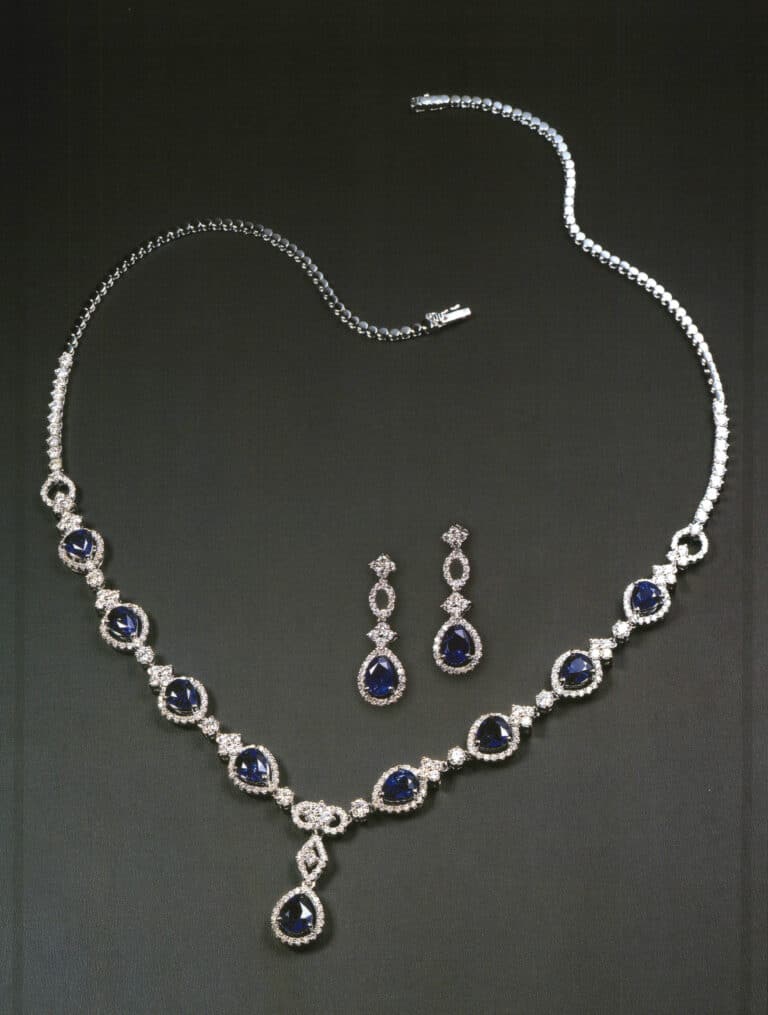
Sri Lanka Sapphire jewelry set including chain and earring
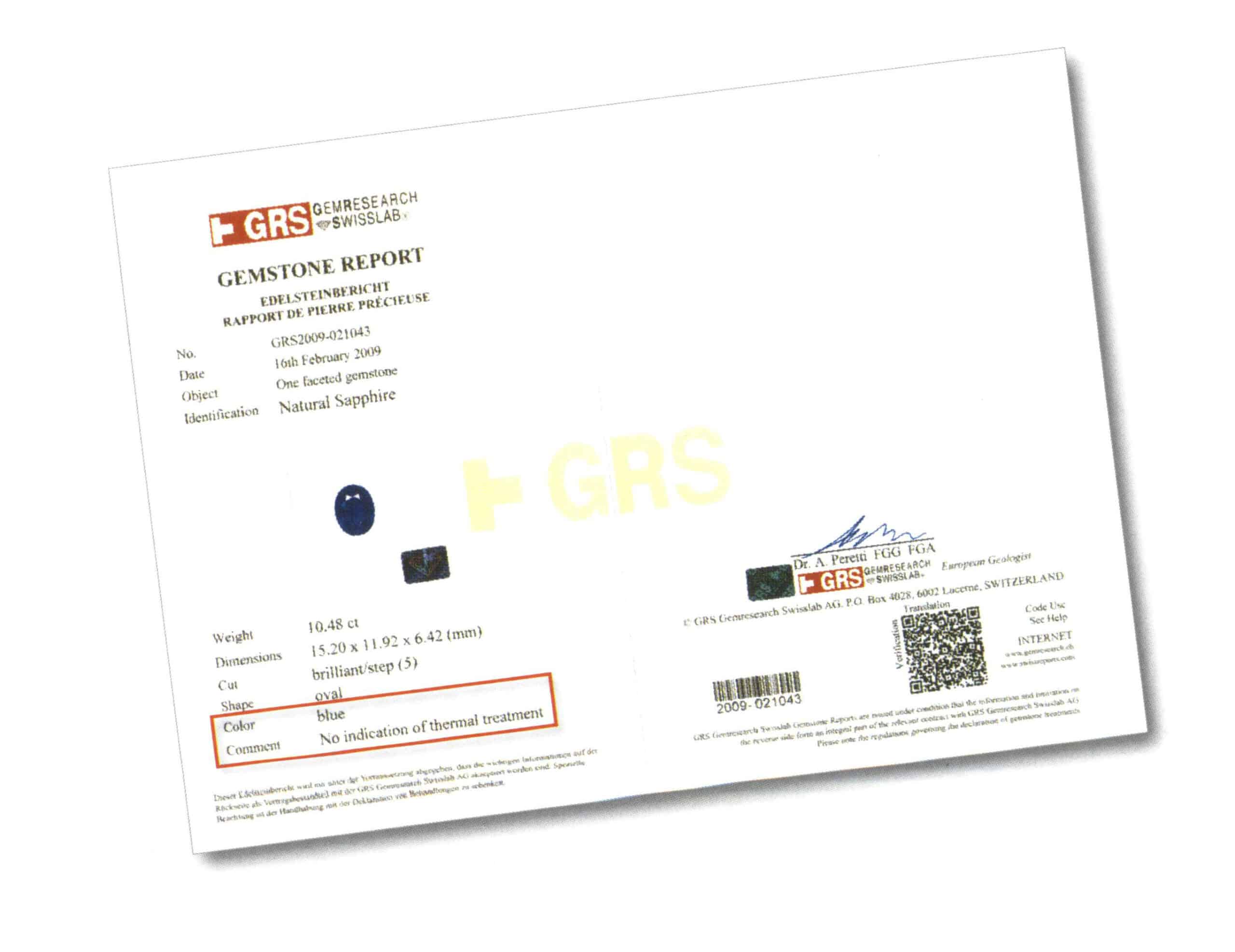
Sapphire GRS certificate, The certificate states, "Natural sapphire without heat treatment.
Cornflower Blue, Royal Blue, Velvet Blue
Cornflower Blue is a sapphire with a hint of purple, mainly sourced from the Kashmir region in northern India, and is recognized as the most beautiful sapphire. Mining has almost ceased, and it can usually be seen at Sotheby’s or Christie’s auctions. Royal Blue refers to sapphires from Myanmar, which has a rich color and is very popular among consumers. Another type, Velvet Blue, is a sapphire from Sri Lanka. It is known for its noble hue and is recognized as a high-quality blue gemstone.

Can I buy a heat-treated blue sapphire?
To avoid purchasing a heat-treated sapphire, finding a reputable seller or someone you know is best. Online auction sellers are more reliable if they offer a return policy within seven days and have a physical store. Additionally, it’s best to have a certification; if it’s an untreated sapphire, having a GRS certificate is more appropriate.
As for whether the second burned blue sapphire is worth buying? It is fine as long as you like it and the price is not expensive. However, I want to remind everyone that red-blue sapphires that have undergone second burning will not change color under normal conditions, including cleaning and ultrasonic cleaning. However, they may fade if exposed to strong acids and bases, their shape or style is modified, or in high-temperature situations.
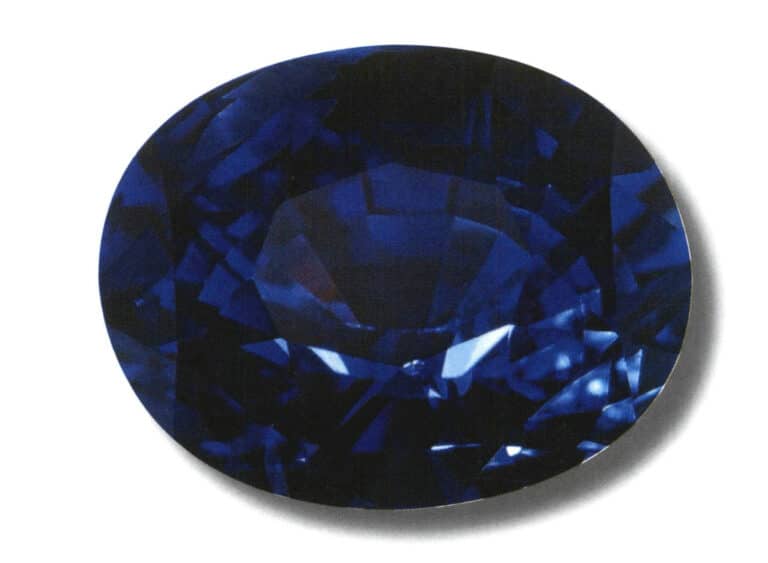
Appreciation of red-blue sapphires
The appreciation criteria for all colored gemstones are similar, focusing on color, fire, transparency, inclusions, and shape.
The color is uniform and does not deviate. Taking rubies as an example, the most vibrant pigeon blood red is the best. The price can vary considerably if the color leans towards peach red or pink. As for the brilliance and the number of facets on the bottom, the more facets there are, the more brilliance there is. Therefore, besides having vibrant colors, Sri Lankan sapphires also have more facets on the bottom, resulting in better brilliance. In contrast, Thai rubies and sapphires have more miniature bottoms and naturally fewer facets, making them less eye-catching than Sri Lankan sapphires.
Furthermore, the higher the transparency, the higher the value of the ruby and sapphire; conversely, even if the gemstone has a good color, if it is opaque, the price will drop significantly. The size, quantity, and distribution of inclusions will also affect consumers’ willingness to purchase. Generally, rubies and sapphires without inclusions can raise doubts among consumers, so it is recommended to be invisible to the naked eye. Additionally, if feather-like inclusions affect the luster, it may be worth giving up. As for the shape is based on personal preference, with oval shapes usually being the most expensive; round shapes appear smaller on the table, making them harder for consumers to accept.
Is the market for red rubies and sapphires on the rise?
A 4-carat ruby from Myanmar, with vibrant and uniform color, excellent brilliance, high transparency, and inclusions invisible to the naked eye, can be priced at over US$37526; conversely, if it is just a red, opaque, non-brilliant ruby with many inclusions, a 4-carat ruby would only be worth at most US$1563. At this point, you should understand that the key is to choose beautiful and heavy gemstones because such gemstones are becoming increasingly rare, so there will be room for appreciation in the future.
Rubies are relatively small in weight, with many raw stones under 1 carat, while high-quality rubies over 1.5 carats are becoming increasingly rare. The market potential for high-quality rubies over 3 carats is even more considerable. There are many sapphires under 2 carats, and Madagascar sapphires of {{0}} carats are not uncommon. The investment return rate for high-quality Sri Lankan sapphires over five cars is relatively high.
3. Pink, Purple Sapphire
Pink sapphire also belongs to the dreamy series of gems for young girls. Many young women do not like rubies’ bright and mature look, so pink sapphire has become the favorite of working women aged 30-40. Pink sapphire is also a favorite among many designers; whether designing flowers or necklaces, it is pretty suitable. The internationally renowned brand BVLGARI used teardrop-shaped pink sapphires to create pink flowers, which are quite charming.
Pink sapphires come in purple, pink-purple, and pink shades, mainly produced in Sri Lanka. The crystal grains are not large, rarely exceeding 5 carats, usually around 1-2 carats. In terms of price, those with purple or pink-purple hues are higher; for pink sapphires over 1 carat, the price is US$312-469 per carat; for those around 2 carats, the price is US$625-781 per carat; for those at 3 carats, the price is US$938-1094 per carat; and for pink sapphires over 4 carats with clean inclusions, they are almost impossible to find.

4. Yellow Sapphire
Yellow sapphire is also a gem “well-known at the top and famous at the bottom” in the corundum family. The color of yellow sapphire ranges from crystal lemon yellow to whiskey yellow, with whiskey yellow generally being the most expensive and lemon yellow being relatively cheaper. Yellow sapphires are much lower than rubies and sapphires, making it a good choice for those looking to step up into the corundum family.
Thai lemon yellow sapphires, most of which are green or blue sapphires that have been heat-treated to change color, are relatively affordable. For a Thai yellow sapphire of1-2carats, the price is US$31-46 per carat; for sizes of 3 to 5 carats, the price is US$78-109 per carat; for sizes of 5 to 10 carats, the price is US$104-203 per carat; for sizes of 10-20 carats, the price is US$312-375 per carat.For sizes of 20 to 50 carats, the price is US$375-469per carat.
As for Sri Lankan yellow sapphires they are only heated once, which is a standard heat treatment. The current production is relatively low; for sizes of1-2carats, the price is US$156-187 per carat; for sizes of 3 to 4 carats, the price is US$187-250 per carat; for sizes above 5 to 10 carats, the price is US$312-469 per carat; Sri Lankan yellow sapphires over 10 carats are pretty rare.
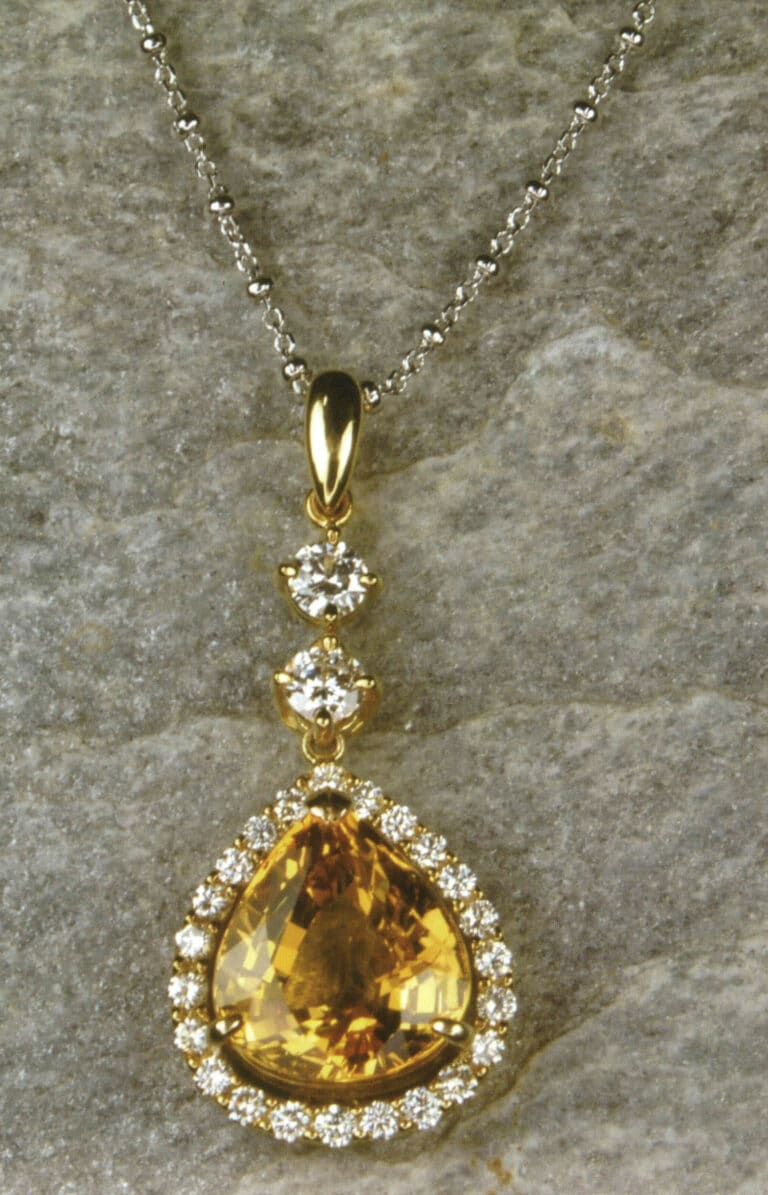
5. Padparadscha Sapphire
Padparadscha is a term in the Sri Lankan language meaning orange-pink, and it is also transliterated as “Papadrascha” sapphire. This gem is unique to Sri Lanka, with minimal production, and is considered a collector’s gem . A friend of mine often travels to Sri Lanka to buy gems, and aside from a cat’s eye stones, he seeks Padparadscha sapphires. After nearly half a month of treasure hunting, he only found 1-2 pieces. Padparadscha sapphires are usually not large, with the most common size being 1-2 carats. The market price for those over 1 carat is about US$938-1250 per carat; for those over 2 carats, the price is US$1250-1563 per carat. Buying Padparadscha sapphires almost always requires a GRS certificate to avoid spending much money on treated (with beryllium) or lower-grade sapphires. There are people online selling beryllium-treated sapphires as Padparadscha sapphires, and consumers spend US$31-93 thinking they got a bargain. Still, beryllium-treated sapphires only cost US$9-15 per carat.
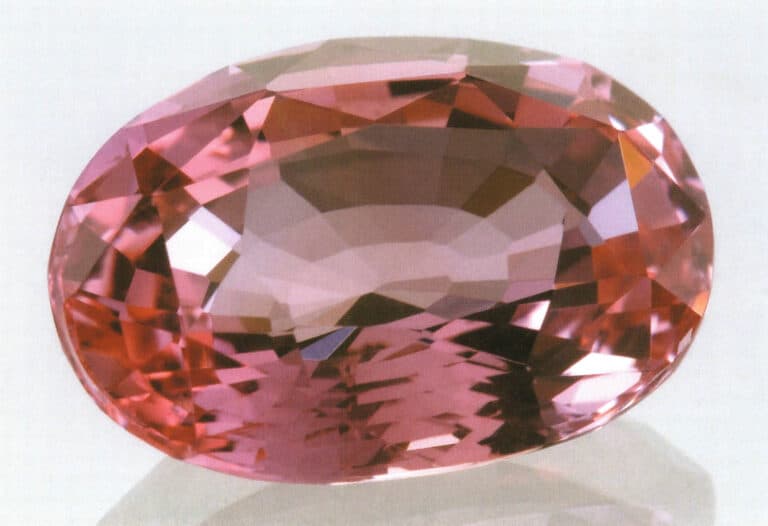
6. Color-Change Corundum
Around 1995, a massive batch of color-change corundum was produced in Africa, with the standard size being 1-3 carats; sizes over 4 carats are relatively rare, and those over 5 carats are even more so. This batch of color-change corundum was likely bought cheaply as domestiC-Grade and then gradually released for profit, making it difficult to find even a little over 1 carat of color-change corundum in Bangkok now. Due to its rarity, it is mainly collected by collectors, and its liquidity is not as widespread as that of rubies and sapphires.
Color-changing corundum ranks second in price among color-changing gemstones, after Alexandrite color-changing stone. Color-changing corundum with more than 1 carat is US$312-375 per 1 carat; those with more than 2 carats in size are US$625-781 per 1 carat; those with 3 to 4 carats in size are US$938-1563 per 1 carat; and those with grades of 5 carats or more are very rare, and the opening price may be US$1563-2501 per 1 carat. Besides size and clarity, the depth of color change also affects the price.

Synthetic corundum usually comes in various colors. Usually bought and sold in kilograms
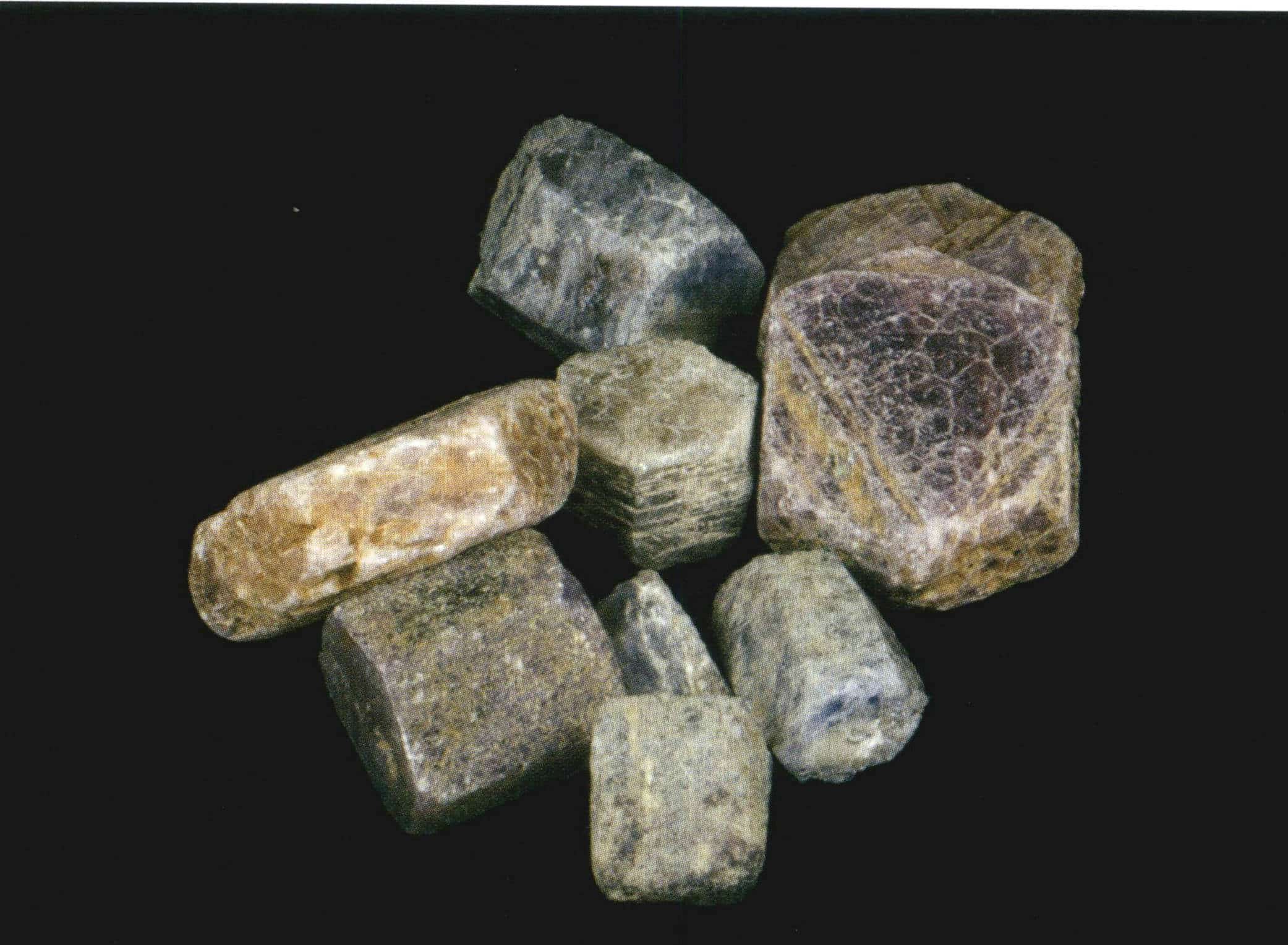
Raw African corundum crystals, which can be picked up as columnar hexahedra, are usually only used as teaching specimens.
7. Asterism Corundum
Many gemstones produce a star effect, among which the star ruby is the most valuable. In 1995, I saw a 10-carat Burmese star ruby at an auction in Yangon, Myanmar, with a starting price of US$312720, which shows the value of star rubies. Star rubies are also considered expert collectibles, with limited circulation in the market, making them harder to liquidate. Currently, the best ones come from Myanmar and Sri Lanka. When selecting, special attention should be paid to the clarity of the star, whether it is centered, if the star is broken, the finer the star rays, the better the transparency, whether the color is vivid, and if there are any cracks.
Burmese star rubies are small, have many impurities, are opaque, and have a light color. A 1-3 carat one can be bought for US$9-18 at jade markets or online auctions. If you want to collect star gemstone specimens, this is a good choice. High-end Burmese or Sri Lankan star sapphires have obvious star rays and are relatively transparent. For sizes of 10-30 carats, each carat costs US$625-1563. Indian star rubies are purple-red and opaque, and are relatively cheap, with those under 10 carats costing about US$9-15; for 10 to 30 carats, each carat costs US$25-31. Thai star black sapphires of ordinary quality at1-5carats cost 1 US$3-9; for 10-50 carats, of higher quality with fewer cracks, each carat costs US$31-62.
There are also synthetic star rubies and sapphires on the market, and they are easy to find when traveling in Southeast Asia, with a price of US$93-156 for one. Additionally, there are also star rubies and sapphires with artificial star rays (the gemstone is natural, but the star rays are artificial), usually over 20 carats, and consumers should be cautious!
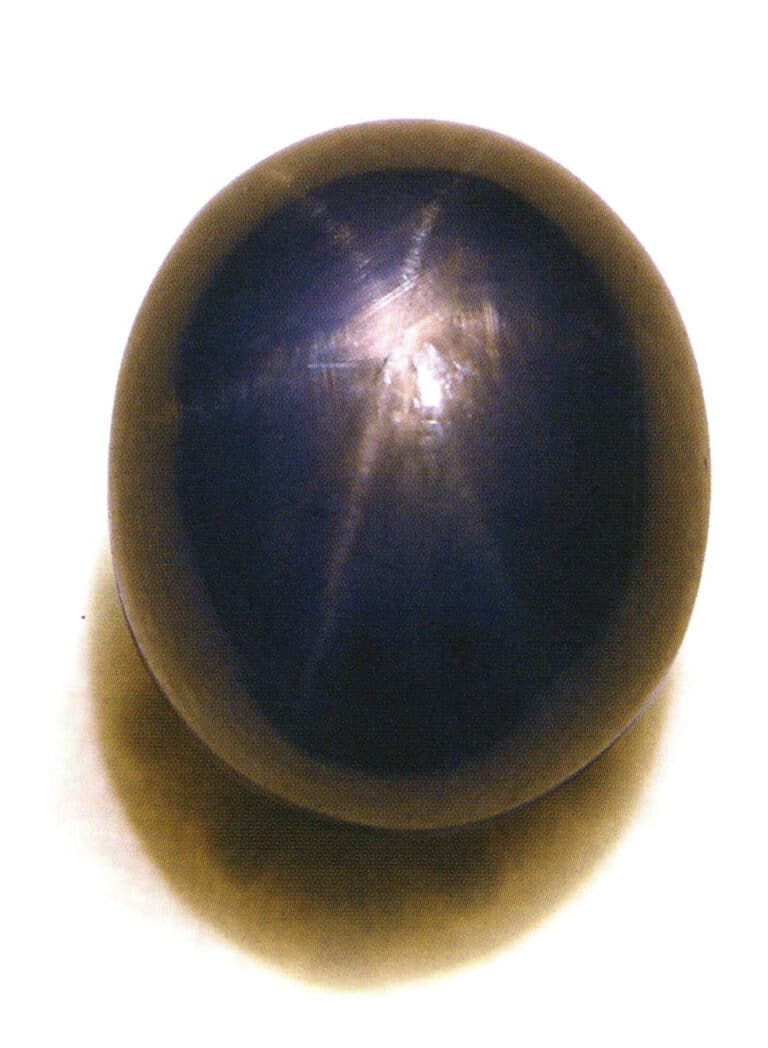
Sri Lanka blue sapphire, market price US$625-938 per carat .
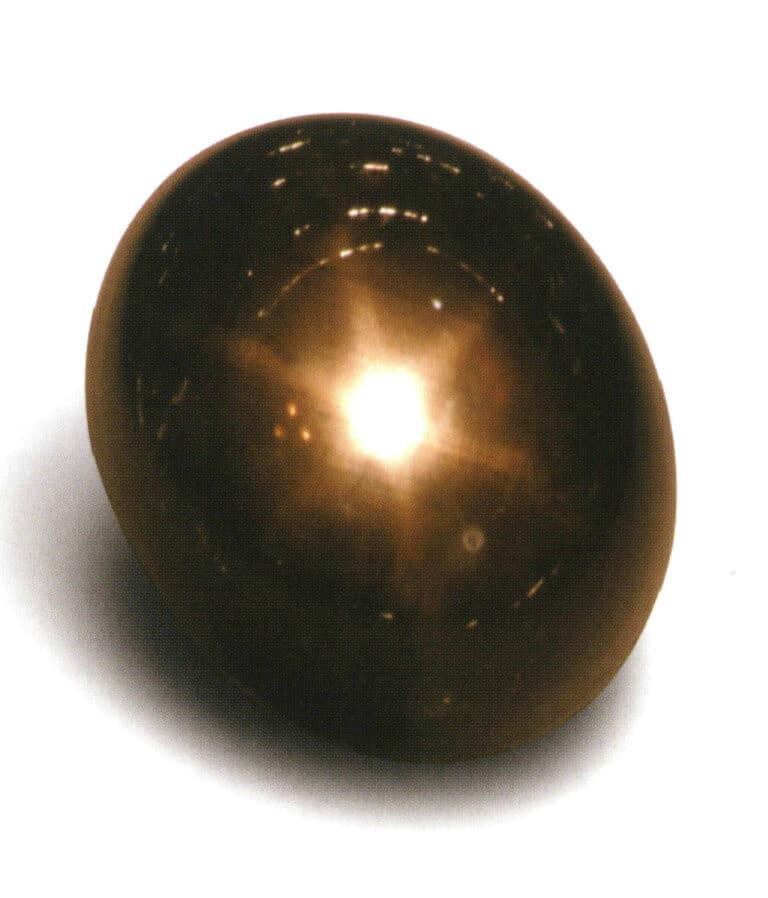
Thai Black Treasure Starstone, the most distinctive of the black gemstones, is also the cheapest of the corundum starstones and the easiest to own easily.
Section IV Jadeite (Burmese jade, imperial jade, hard jade)
Jadeite is not actually an academic term, as its main component is sodium-bearing pyroxene, which geologists refer to as “imperial jade,” meaning brilliant and dazzling. Jadeite is a commercial term, and it is also referred to as “Burmese jade” because it comes from Myanmar. The Japanese translate it as hard jade, and many scholars in China and mainland China continue to use this term, although some scholars do not use it because the hardness of nephrite is higher than that of jadeite.
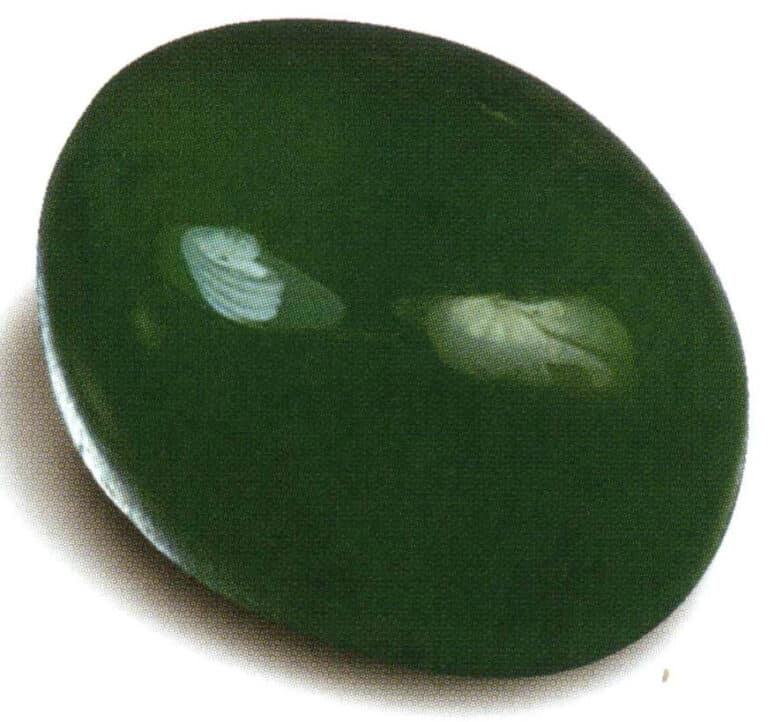
| Σύνθεση | Σύστημα κρυστάλλων | Σκληρότητα | Ειδικό βάρος | Δείκτης διάθλασης | Χρώμα | Διάσπαση | Θραύση |
|---|---|---|---|---|---|---|---|
| NaAlSi2O6 | Μονοκλινές σύστημα | 6.5 ~ 7 | 3.33 | 1.66 ~ 1.68 | Apple green to emerald green, red, yellow, purple, black, and white | Belongs to a composite structure, with cleavage not visible | Granular fracture |
1. Varieties of jadeite
There are many types of jadeite, and the general market classification may confuse readers, leaving them in a fog and at a loss. The classifications of mineralogy and gemology are also quite different. I suggest distinguishing jade based on its texture, color, and crystal coarseness. Generally, high-quality jade has high transparency and bright, uniform color, while the opposite indicates lower-quality jade. In addition, the abundance of associated minerals and the distribution of cracks are also important factors affecting quality.
Burmese jade can be classified as transparent, semi-transparent, and opaque based on its texture. For example, the jade commonly referred to as “glass type” is as transparent as glass, and if it is emerald green, it is the beloved jadeite. Ice-type jade has a semi-transparent transparency level; generally, jadeite of ice type is considered quite good. As for opaque jade, the crystalline particles are coarse, and the quality is poorer. An opaque white jade bracelet can be purchased for US$15-46, starkly contrasting the price of glass-type jadeite bracelets that can easily reach millions of dollars..
The following explains some standard commercial terms seen in the market:
Long history Mining area
Many shopkeepers will say it is old jade excavated from older Mining area. ” older Mining” refers not to age but to high-quality, deep green jade with a vibrant color. It implies that the price is costly.
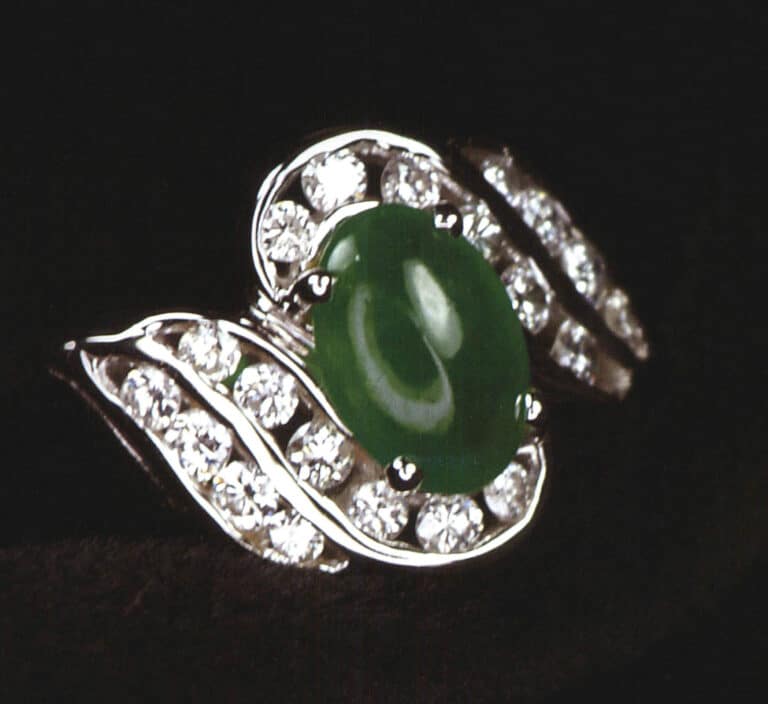
Διαφάνεια
Jade with a transparent texture as transparent as glass is the highest quality grade.
Ice type
The jadeite texture is semi-transparent, like ice, and is also quite rare. Choosing a texture above ice type is best when purchasing jadeite, but the prices are costly.
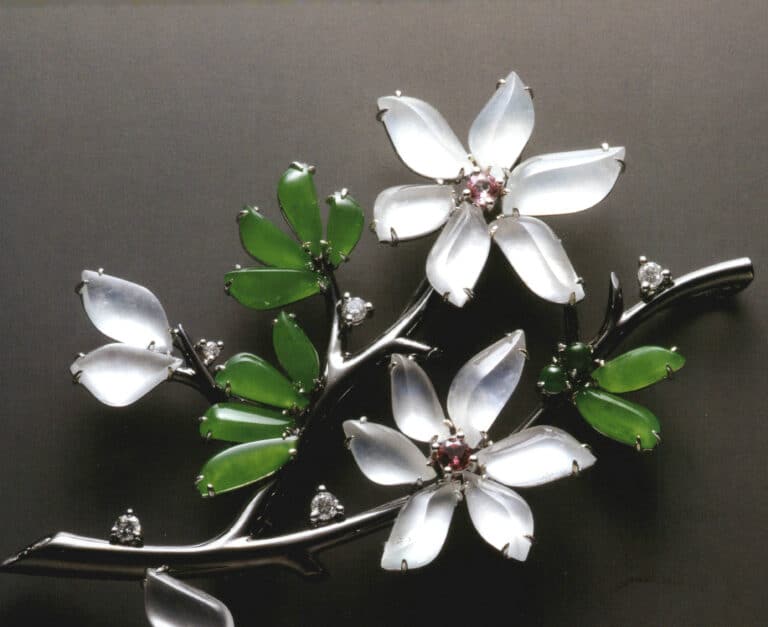
White base green
Mainly white with some green mixed in, mostly opaque, with the green distributed in stripes or flakes. Finding white base green bracelets on the market is now quite difficult.
Green color type
The base color is light green or other colors, with the green parts irregularly scattered, mixed with some black or other colors, which is a more common type of jade on the market. Due to the distribution of many black amphibole minerals, young people tend to dislike it. According to my survey, those who like flower green jade mainly belong to noble mature women aged 60 and above. The price of flower green jade bracelets varies based on the depth of green, distribution, and the amount of black speck impurities, starting from US$1563, the larger green area can cost US$15636-31272.
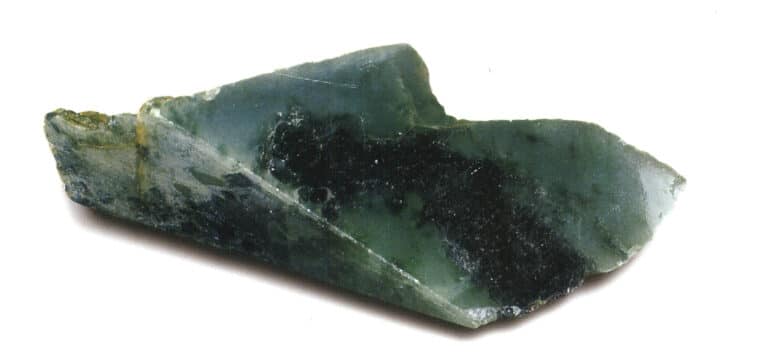
Bean green type
The crystal grains are relatively coarse, and the crystallization can be seen with the naked eye, resembling green beans, usually opaque and light green. Due to its opaque texture and noticeable crystal grains, the price is low, typically ranging from US$312-1563. However, if it is a fully green and vibrant bean green jade bracelet, the market price can reach US$9381-12508.

Oil Green Variety
The color is uniform, appears deep blue or blue-green, has a greasy luster on the surface, and is usually not expensive. Generally speaking, people from the northern Chinese prefer this color of Jade.
Padparadscha Variety
The color is lighter, similar to apple green, semi-transparent, with a glassy luster, and sometimes the color is distributed like ribbons. The current market price for Padparadscha variety bracelets is at least US$938-1563 and can go up to over US$3127.
Tri-colored jade
As the name suggests, it refers to Jade with three colors. Initially, it referred to the three colors of green, purple, and white; nowadays, regardless of the colors (such as green, yellow, purple, or green, red, purple), as long as the Jade has three colors, it can be called ” Tri-colored jade.” When selecting a three-color jade pendant and looking at the color distribution, the carving’s connotation is also quite important. “Three-color jade.” Many merchants will say that three-color jade is old from a long time ago; it has nothing to do with age but is produced by grinding the brownish-yellow jade skin with the green and purple inside. The price of a three-color jade bracelet varies based on color distribution and texture, starting from US$1563-6254.
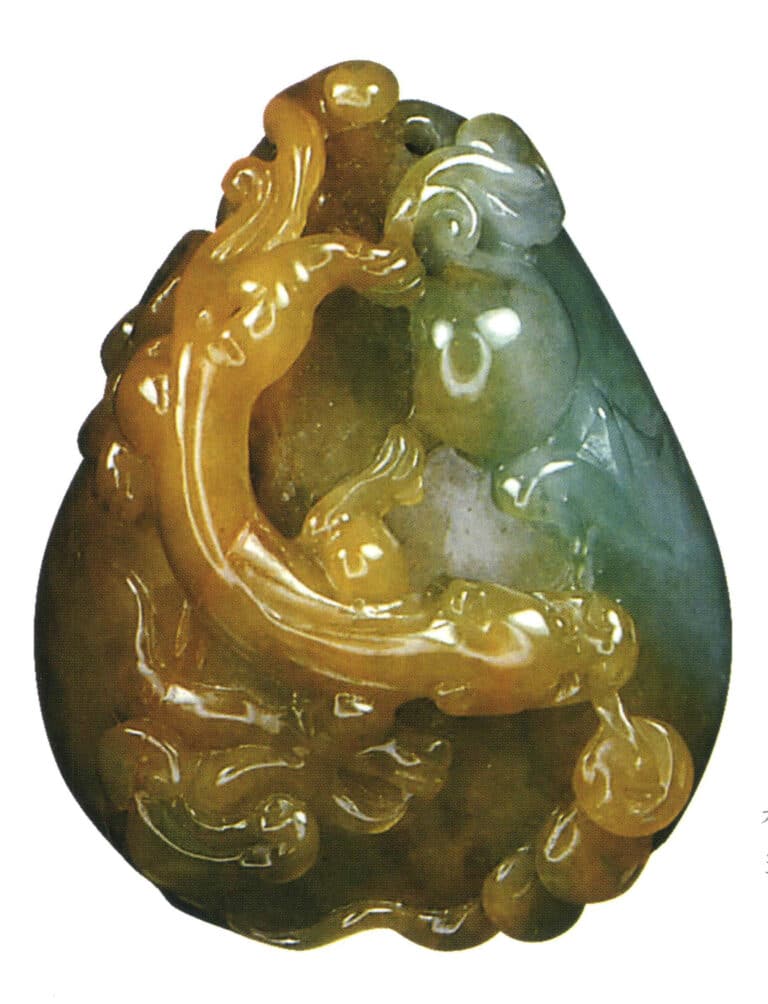
Blood Jade
The reason blood jade appears reddish-brown is due to the weathering of the jade stone. Older individuals favor blood jade in China. There is also a type called “honey yellow” jade, which is yellowish-brown, and its formation is similar to that of blood jade, preferred by women around 30-40 years old. The market price of blood jade in the jade bracelet market is US$6254-12508, while honey yellow bracelets are priced at US$1563-4690. Honey yellow is a color favored by the younger demographic, predominantly in light yellow and yellow-brown shades.

Violet Jade
The color of violet jade gives a romantic and mysterious feeling, making it quite popular among young people. Currently, high-quality, transparent violet jade is becoming increasingly rare. A regular opaque violet jade bracelet costs US$938 on the mainland, while an ice-type violet jade can fetch as high as US$4690-6254. In 2000, I bought seven ice-type violet jade bracelets for US$3752 at Guanghua Jade Market, one of which was nearly 3/4 purple and quite beautiful. It is now estimated to be worth US$15636-25017. Because genuine pieces are hard to find, dyed purple jade bracelets or pendants often appear on the market. If you look closely and see that the color in the cracks is intense, it is likely dyed purple Jade.

Dark green jade
Ink jade is a new species discovered around 1993, from the appearance of black, in the strong light (fiber lamp) is dark green, the China has the introduction of the industry, and vigorously promote, in the force of speculation, Dark green jade ‘s price remains high, and early on there is even a ring rose to US$9381-15636, but with the downturn in the economy, the price of the current price and Return to normal. At the World Trade Jewelry Exhibition in September 2000, a men’s egg-shaped ring was priced at about 10,000 TWD. In 2010, the price of Mo Cui rose again, with a bracelet costing between US$6254-9381. Ink and green ring. Many people like the color Ink jade, a unique variety of Jade. Especially after being illuminated, the emerald green it presents is genuinely captivating.
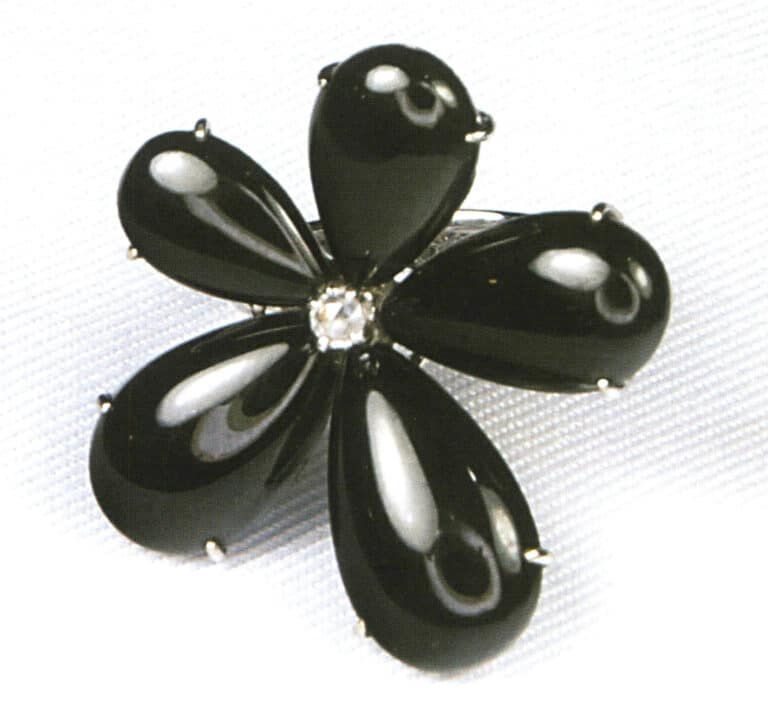
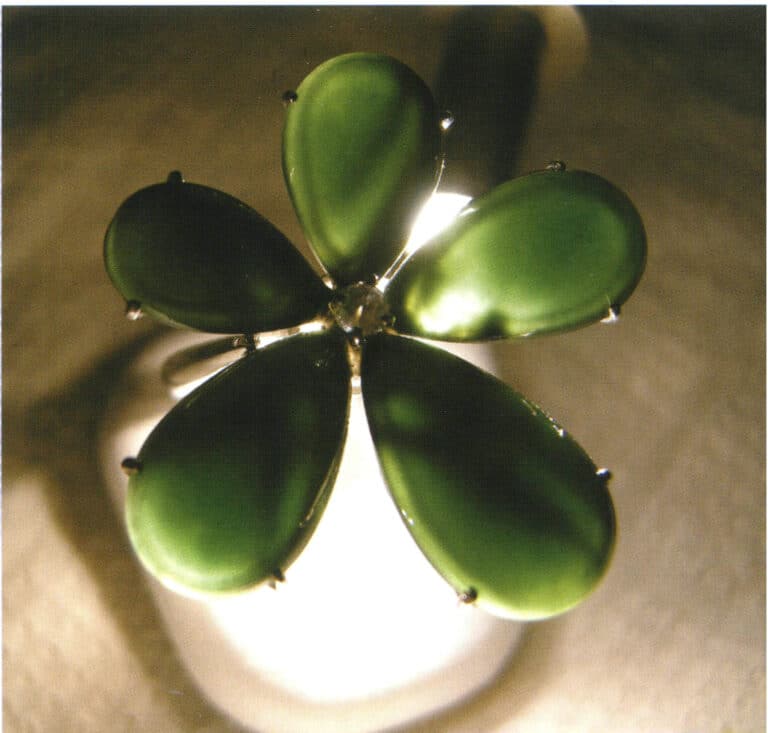
Ink and green ring. Many people like the color Ink jade, a unique variety of Jade. Especially after being illuminated, the emerald green it presents is genuinely captivating.
Dry Green
The color is relatively bright green, usually associated with chromite (black spots); the surface is opaque and has a poor luster when polished (industry insiders say it lacks moisture).
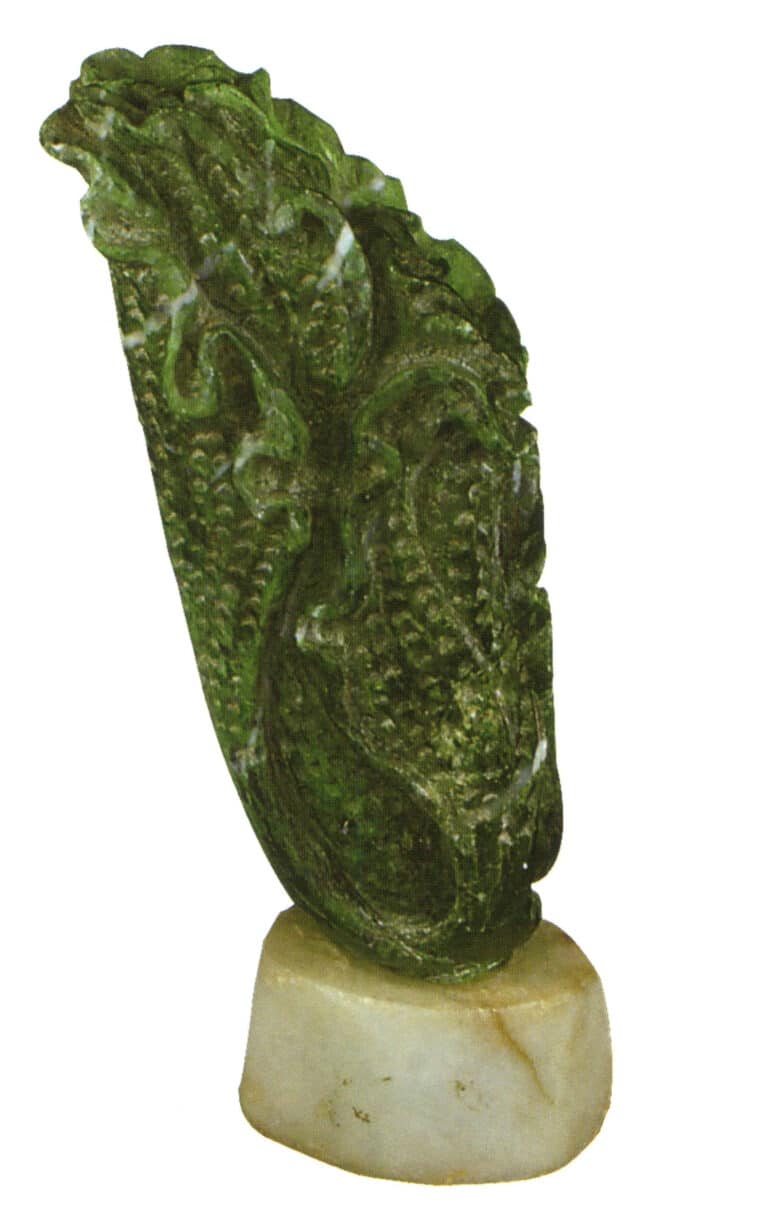
Moses the Western Jade
Moses the Western Jade was discovered around 1991. The most significant difference from the Ganqing jade is that its color is less vibrant than green. The main mineral components are sodium chromium pyroxene and chromite, with minor components being amphibole and enstatite. Its texture is quite complex, with few cracks, often mixed with some black spots. When Moses the Western Jade was first discovered, it was priced relatively high but did not respond significantly in the market.

The eight-third jade variety
The eight-third jade was discovered in 1983 as a new jade mine. The raw stone is opaque and has a soft texture, light apple green color, and purple often coexists with green. Due to the many cracks in the eight-third jade, merchants usually optimize it as “B-grade.” After optimization, the texture becomes transparent, and the green part deepens. Because it is cheap and attractive, many unsuspecting consumers flock to it. Since the raw material for the eight-third jade is inexpensive, the finished product after optimization is clean and beautiful, leading many merchants who originally sold A-grade to join the ranks of selling the eight-third jade. The eight-third jade bracelets were initially priced at US$625-938. But after a few years later, the price was only left with US$426-710. Additionally, the surface glue of B-grade 83 jade is easily weathered and turns yellow; even if polished again, it won’t shine. Moreover, I have heard of cases where jade with injected glue was used to “settle debts”: someone reached the deadline for borrowing money but had no cash to repay, so they brought three family heirloom bracelets claiming to be worth a lot to settle the debt. The creditor sent them to a silver shop for appraisal, and some silver jewelry shops, not understanding, thought they were high-end glass jade, quoting one at US$71065-142131, while in fact, one jade bracelet is only worth US$426-710.
Full Green
This type of jade was the hottest topic in the Chinese market around 1998. Due to its beautiful color, it caused chaos in the domestic market when it was first introduced from Myanmar. Tie Long Sheng jade has a jadeite-like emerald green, mixed with many black spots, mostly opaque, and has many cracks. Its main components are jadeite and sodium-rich hornblende, with some having a specific gravity lower than 3.32 containing a lot of sodium feldspar. Tie Long Sheng jade with more sodium feldspar has many cracks and is soft in texture, thus requiring glue treatment. In contrast, those with heavier specific gravity and fewer cracks appear in A-grade form and are more expensive. For example, a bead chain with a bead diameter of 7-8 millimeters and a length of 41 centimeters, B-grade is about US$2842-4263, while A-grade costs US$14213-28426.
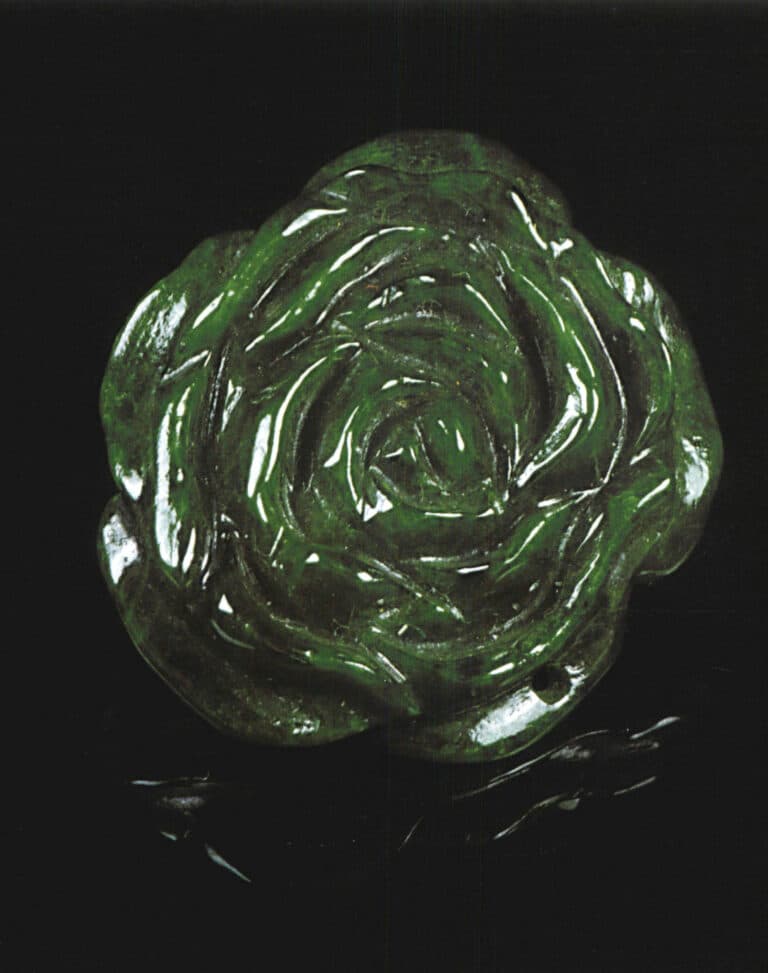
2. What are A, B, C, and "B+C" jade?
The so-called “A jade” or “A-Grade” refers to jadeite that is natural jade (including surface wax), which has only been soaked in sour plum water to remove the grease.
“B jade” or “B-Grade” refers to natural jadeite soaked in acid (usually hydrochloric acid) to remove secondary mineral impurities (such as hematite or limonite), making the surface of the jadeite appear cleaner. This step is known as deyellowing (commonly referred to as bleaching), followed by resin filling (usually with transparent colorless resin). The purpose of resin filling is to fill the voids created by the removal of impurities and to increase strength.
“C jade” or “C-Grade” refers to jade that has a white exterior but is dyed in various colors, with the most common on the market being dyed green, red, or purple.
Additionally, “B+C jade” or “B+C-Grade” refers to jade itself being treated to remove yellow and infused with green resin, making the color more vibrant and ensuring it never fades.
3. How to buy jadeite?
First
look at the color; the greener and more uniform the color, the more expensive it is. Unique violet, rare black jade, or tri-colored jade are distinctive and also worth purchasing.
Second
check the transparency; the more transparent, the better the quality.
Third
examine the thickness and impurities; the thicker it is, the higher the value, and the fewer internal cracks and black impurities, the better.
Fourth
look at the carving. Exquisite craftsmanship has a positive effect; even ordinary jadeite, after being carved by a master, can significantly increase in value, sometimes by dozens of times. For example, Master Huang Fushou, with his clever composition and superb skills, has reached an unparalleled level of artistry. Master Huang departs from the traditional method of carving statues of deities or animals in the Chinese Zodiac and incorporates flowers, plants and insects into his works, so delicate that even the tentacle hairs on the insect’s feet are lifelike, making him the 21st century Chinese jade carving master.
In addition to the basic rules mentioned above, when buying jadeite bracelets, check for cracks; the fewer cracks, the better. When buying pendants, pay attention to the thickness; do not choose ones that are too thin. This is because they are prone to breaking during setting and can easily be damaged upon impact. Additionally, pendants are often made from the middle or edge scraps of bracelets, so try to choose oval or round shapes. If it is a carved pendant, first check the detail of the carving; when purchasing, you can use a magnifying glass to inspect the edges. Secondly, consider the meanings, such as bamboo representing rising success, ingots bringing wealth, and fish representing abundance year after year. Additionally, the best-selling jade pendants in China are often related to religion, such as Maitreya Buddha, Guanyin.
4. Can wearing jade ward off evil? Is it true?
Eastern people have loved jade for over five thousand years. There are folk tales that wearing jade can ward off evil, but can jade really ward off evil? Is there scientific proof? So far, no scientist has the answer, but such tales are often heard: some people listened to their grandmothers and wore jade pendants on their chests, and when bullets hit the jade pendant on the battlefield, they remained unharmed;
Passed down through word of mouth, many people believe that wearing jade carvings of Buddha or Guanyin will always bring blessings from the Buddha, no matter when or where; Christians also like to wear jade crosses, representing God’s redemption and the power of Jesus’ resurrection; children who wear jade pendants can be safe, grow smoothly, and excel in exams… Regardless of whether this is a spiritual belief or has some truth, the public’s willingness to believe gives businesses the greatest opportunity. I want to remind you again that the composition of jade is the same; if you believe jade can ward off evil, regardless of its price, it has an effect. If someone wants to change their fortune, a regular jade pendant or seal, claimed to be blessed by a certain master or teacher, may cost you tens of thousands to hundreds of thousands; be careful not to be deceived! When you don’t buy these products, the master will say that your family members will encounter misfortune or accidents, or that you don’t have cash and must use a credit card or check; don’t be fooled. Imagine: you bought these precious jades, allowing their family to improve their living conditions, drive a Mercedes, dine in high-end restaurants, and enjoy life, while you? You went into debt to buy a fortune-changing jade, yet you have to continue repaying the debt, becoming poorer, and your fortune is getting worse!
Jade itself is innocent; it is human greed that uses it as a tool for crime. If you really feel helpless, you can seek assistance from social services or find a psychologist. Otherwise, I can pray for you for free, asking God to bless your family with peace and success in your career. Spend money where it should be spent, work actively and earnestly, and you can definitely change your luck.
5. How to determine the authenticity of jade by burning hair?
There is a method circulating in the community to determine the authenticity of jade, which involves tying a strand of hair to the jade and burning it with a lighter. If the hair breaks, the jade is fake; if it doesn’t break, it’s real jade. I have conducted this experiment several times, asking all the friends to pull a hair and tie it to different types of jade. I found that most of the hair on real jade does not burn (about 80%), while hair on glass or dyed jade tends to burn. The key point is that this method cannot test the quality of jade; it’s just a fun activity to do when bored and shouldn’t be taken seriously.
6. Does jadeite get greener the more you wear it?
I often hear shopkeepers say that jadeite gets greener the more you wear it. Is this true? Could it be just a sales pitch? Is there any scientific basis for this? In fact, jadeite may get greener the more you wear it, or it may not change color at all. The reason is that jadeite has a flaky structure, and if you magnify it 2000-3000 times under a microscope, you can clearly see its flaky structure. When jadeite is worn, the skin secretes oils, just like how human skin needs lotion. When the oil penetrates and moisturizes the jadeite, the originally light green color or green threads will gradually look better and darker, which is what the merchants refer to as getting greener the more you wear it. If you buy it and leave it untouched, the color will not become greener. Additionally, if the jade itself has no color, it cannot turn green no matter how you wear it. If a merchant claims that the jade’s color becomes murky or dark indicates that you are unhealthy, do not be deceived. In fact, the color of jade can become murky or dark for two reasons: first, the quality of the jade itself is poor and has many impurities, so it won’t turn green no matter how you wear it. Second, it may be B-grade or treated jade (fire-baked), with a dull or weathered surface, so the color will naturally not look good. This has nothing to do with your health; it’s just an excuse for the shopkeeper to get you to buy new jade!
7. Should I choose based on quality or color?
In the past, Chinese people prioritized the color of jade, followed by its quality. It wasn’t until around 1995 that they gradually learned to first choose quality before selecting color. If one wants both, they might have to pay the price of a luxury home. To be honest, the timing for buying jadeite has become a bit late now because “the prices are too high.” Generally, those with an average salary can’t afford what they find appealing; the cheaper options are of poor quality and are not desirable.
If you really want to buy jadeite, it is recommended to look for ice-type jadeite. You can choose ice-type colorless or slightly greenish bangles, or ice-type with a hint of violet color, which tends to retain value better. If you prioritize color, you can choose rose-type, bean green type, or white base green, with entry-level purchase prices ranging from US$1421-14213.
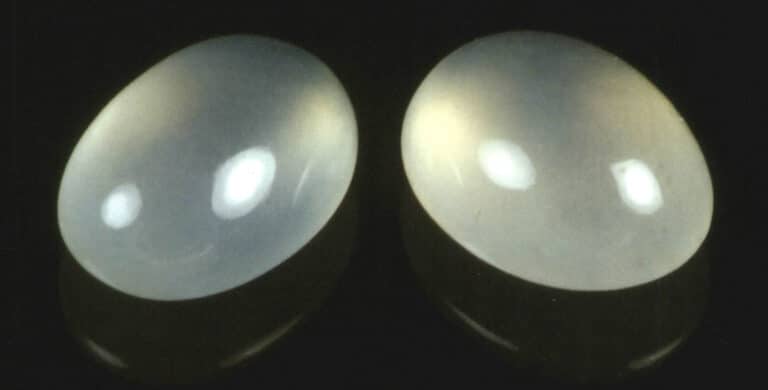
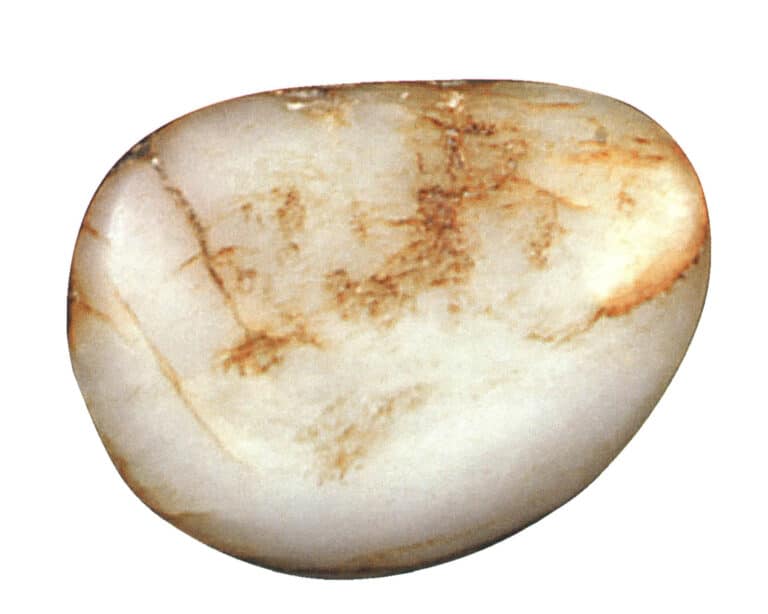
8. Common jade imitations
The definition of “jade” usually refers to two specific minerals—nephrite or jadeite, but common jade imitations often carry the word “jade,” such as “South African jade,” which is hydro garnet; “Swiss jade” refers to chalcedony, etc. Because nephrite is rare, has high hardness, and beautiful colors, its price is much higher than other minerals, leading to the emergence of many imitations. Here are a few examples of faux jade for your reference.
Marble
They are known as Han white jade in china. Primarily white, relatively light in weight, and will bubble when encountering hydrochloric acid.
Dushan jade
It is produced in the Dushan area of Nanyang City, Henan Province, also known as Dushan jade or Nanyang jade. The colors include red, yellow, green, and blue, distributed in scattered spots. Its specific gravity is similar to jadeite, with the main components plagioclase, nephrite, and tremolite. It is not commonly seen in China.
Calcium feldspar
The surface of green plagioclase has green spots, which are different from the green fibrous or flaky inclusions in jadeite, and it has a lighter specific gravity, appearing semi-transparent or opaque. A string of bracelets costs US$42-71.
Hsiuyen jade
The most commonly seen on the market, produced in Xiuyan County, Liaoning Province, is serpentine skin texture pattern. It has a lighter specific gravity than jadeite, with colors including yellow, yellow-green, and dark green.
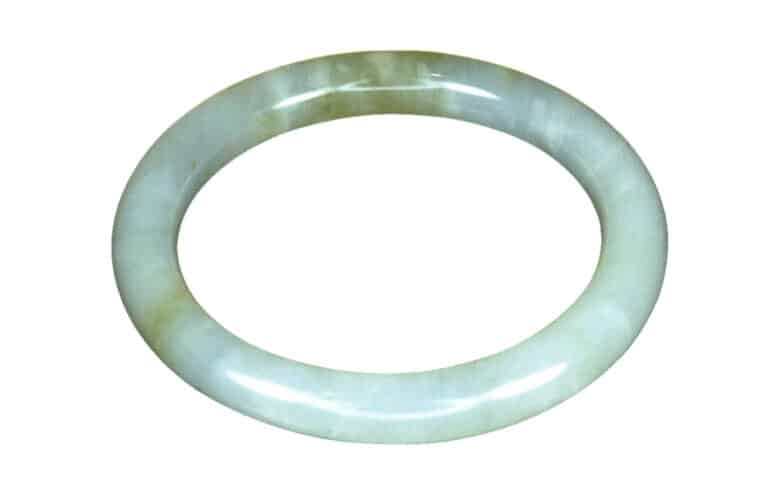
Australian jade
It is a green quartz containing nickel, semi-transparent, with a specific gravity of about 2.65. This is the most commonly used gemstone to impersonate jade, characterized by its uniform color, presenting an apple green, and is most often made into ring faces or bead chains. High-quality Australian jade is also not cheap at the Hong Kong jewelry fair..
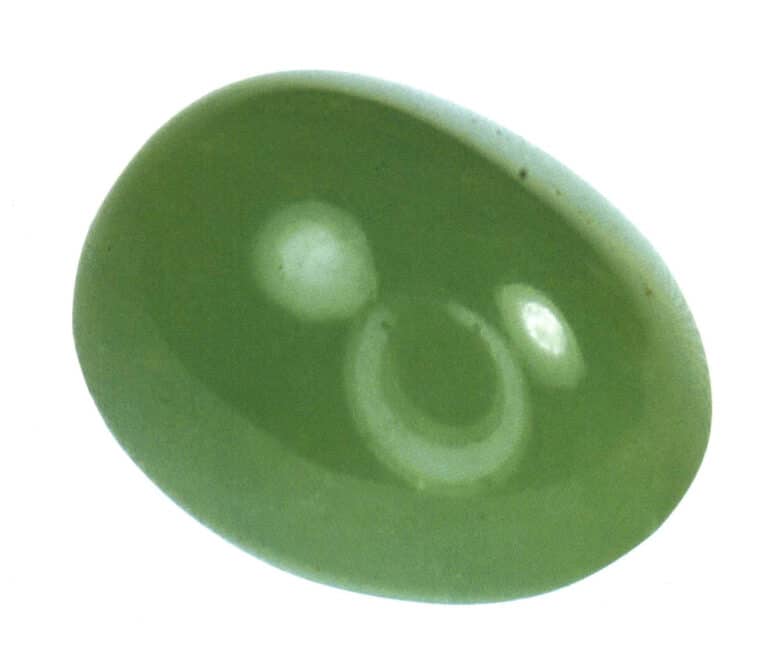
Taiwan jade
Taiwan jade is darker green, with a specific gravity of about 3.0. It can float on a liquid with a specific gravity of 3.32 (similar types of jade include Hetian jade, Canadian jade, Siberian jade, Australian black jade, and Korean jade).
Sodium feldspar
Recently, a mineral was discovered in Myanmar, the main component being sodium feldspar. At first glance, it may be mistaken for high-grade glass-type jadeite, and it can also have a light green color, with some showing purple. According to appraiser, some translucent or opaque sodium feldspar can produce a fluorescent reaction under fluorescent lights, appearing to glow to the naked eye. Because the main component of it is sodium feldspar, it is often mistakenly thought to be gorgeous B-grade jade. Natural it is tough and cannot be treated with resin. Professor Wu stated that the price of it is relatively high and cannot be optimized, which reduces its inherent value. Therefore, if a glass-type white jade bracelet is sold for 20,000 to 30,000 New China dollars (approximately 4,400-6,600 yuan), one should suspect whether it is it or B-grade jade.
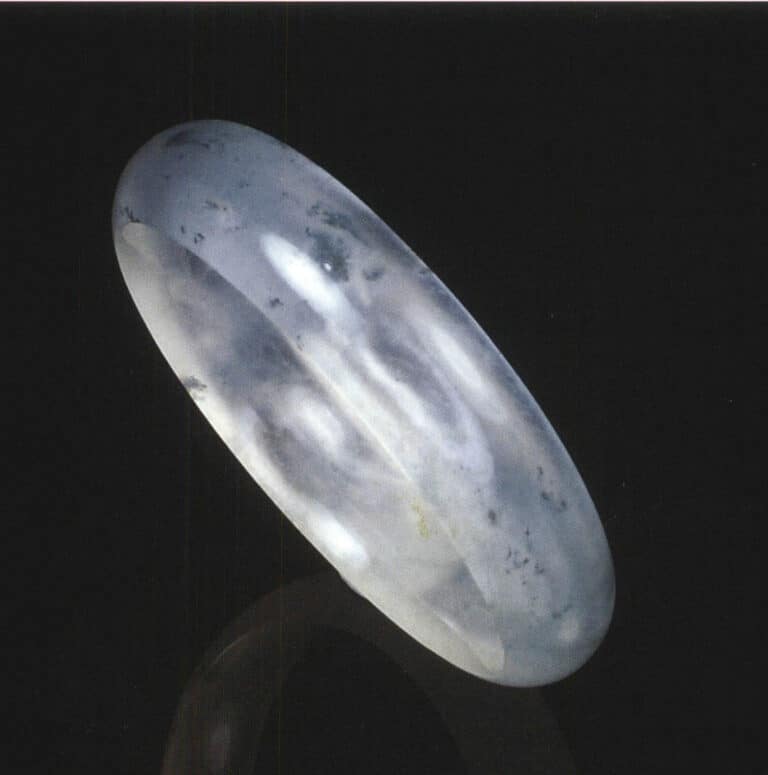
9. Where is the cheapest and most reliable place to buy jade?
With so many imitation jade products on the market, where can one buy relatively cheap and reliable jade? For the average person, buying from jewelry stores is generally more secure but tends to be more expensive; online auctions or the Jianguo Jade Market offer more chances to find cheaper options, but they are comparatively less secure. This also relates to how much you know about jadeite and your level of expertise. If you have a particular understanding of jadeite and the seller can provide you with a certification that you trust, then you can compare prices online or at the jade market; if you have friends or relatives who own silver jewelry shops or jewelry stores, or if you have acquaintances who can introduce you, you can undoubtedly get more discounts and have more security. Some people buy parts to assemble a computer tosave money, while others prefer to spend a little more to buy a laptop with brand assurance. Consumers can weigh their own needs.
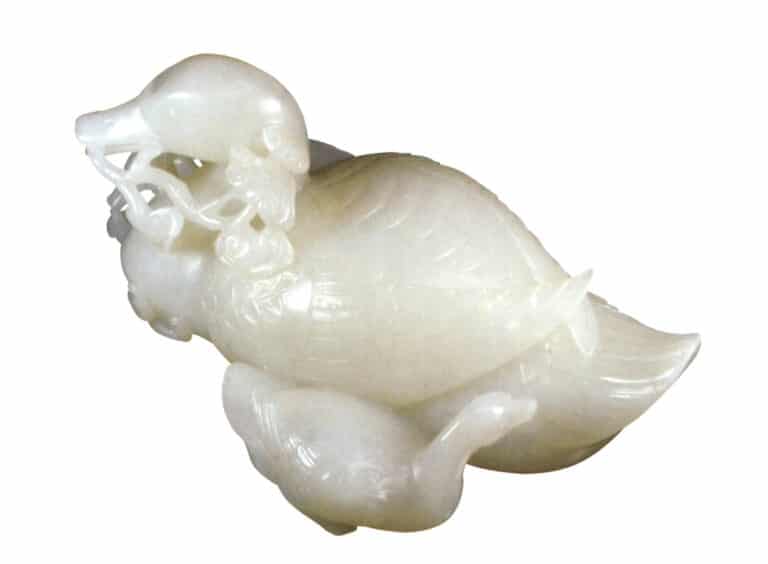
Section V Chrysoberyl
Chrysoberyl comes in green, golden yellow, yellow-green, coffee brown, etc., with green, golden yellow and yellow-green being the most popular; the standard size is 1-3 carats, with a market price of US$142-255 per carat. Chrysoberyl over 10 carats is relatively rare, priced at US$497-639 per carat.
Most people are unfamiliar with Chrysoberyl, and some may mistakenly think it is a type of jade, but it has no relation to jade. Looking at Chrysoberyl, “Chryso” in Greek means golden yellow, while “Beryl” refers to emerald, so is it golden emerald? The two are completely unrelated. Don’t worry if you don’t understand; even I was confused when I first encountered gemology, and it is easy to mix them up. However, I believe you will be familiar with the members of the Chrysoberyl family introduced below!
| Σύνθεση | Σύστημα κρυστάλλων | Σκληρότητα | Ειδικό βάρος | Δείκτης διάθλασης | Χρώμα | Διάσπαση | Θραύση |
|---|---|---|---|---|---|---|---|
| BeAl2O4 | Ορθορομβικό | 8.5 | 3.71 | 1.74 ~ 1.75 | Reddish-brown to yellow-green | Incomplete, columnar | Uneven shell-like |
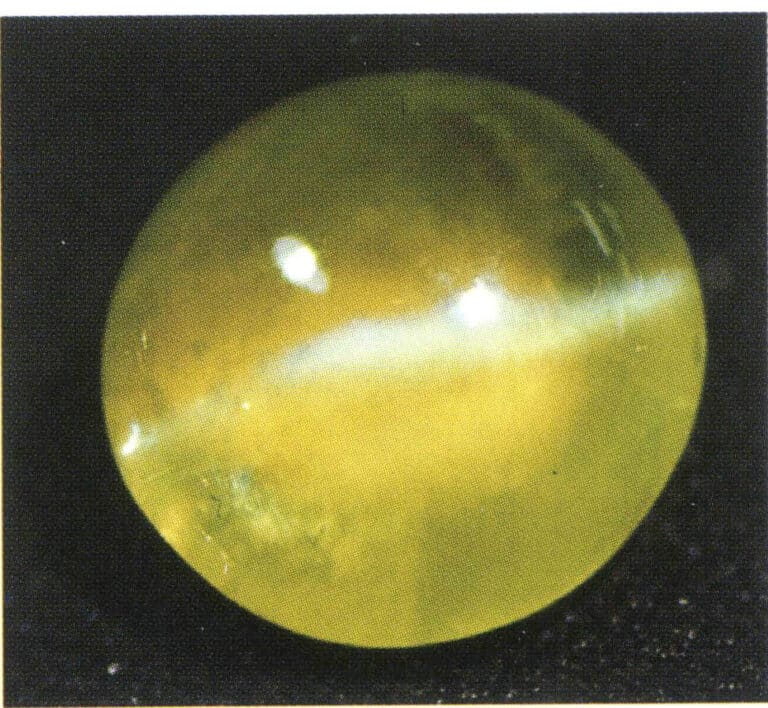
1. Cat's-eye Chrysoberyl
You must have heard of “cat’s-eye stone.” The cat’s-eye phenomenon in gemstones is mainly due to many long, parallel fibers within the stone. When illuminated, the gemstone can exhibit a phenomenon that resembles a cat’s eye-opening and closing, called a cat’s-eye. Many gemstones can exhibit the cat’s-eye phenomenon, such as cat’s-eye diopside, cat’s-eye quartz, cat’s-eye tourmaline, cat’s-eye apatite, and cat’s-eye jade from China. However, referring to “cat’s-eye stone” specifically means cat’s-eye Chrysoberyl.
Cat’s eye chrysoberyl is mainly produced in Sri Lanka, Brazil, and Africa. It is the king of cat’s eyes, with those over 5 carats being particularly valuable. The price of a 5-carat cat’s eye is US$7106-28426, which cannot be compared to other gemstones. When selecting cat’s eye stones, the priority is color, with milk and honey color to brown shades being the most popular; the second is to look at the cat’s eye line, which should not be too thick or broken, and the line should be lively and straight. “Lively” means that under varying light sources, the cat’s eye line will open and close; “straight” means that under light, the line is perfectly centered in the gemstone. This is also the criterion for selecting various cat’s eyes. The “golden line green jade cat’s eye” produced in Sri Lanka is a top-quality cat’s eye, known locally as “lion’s eye,” and is about 30% more expensive than the average golden green jade cat’s eye.
Additionally, the fewer impurities, the higher the transparency, and the absence of cracks in golden green jade cat’s eyes, the more expensive they are. Although cat’s eye stones are the king of cat’s eyes, opaque golden green jade cat’s eyes can be found at online auctions or jade markets, with opaque small cat’s eyes around 1 carat available for about US$42-71 per carat, making them the best entry-level option for beginners collecting gemstone specimens.
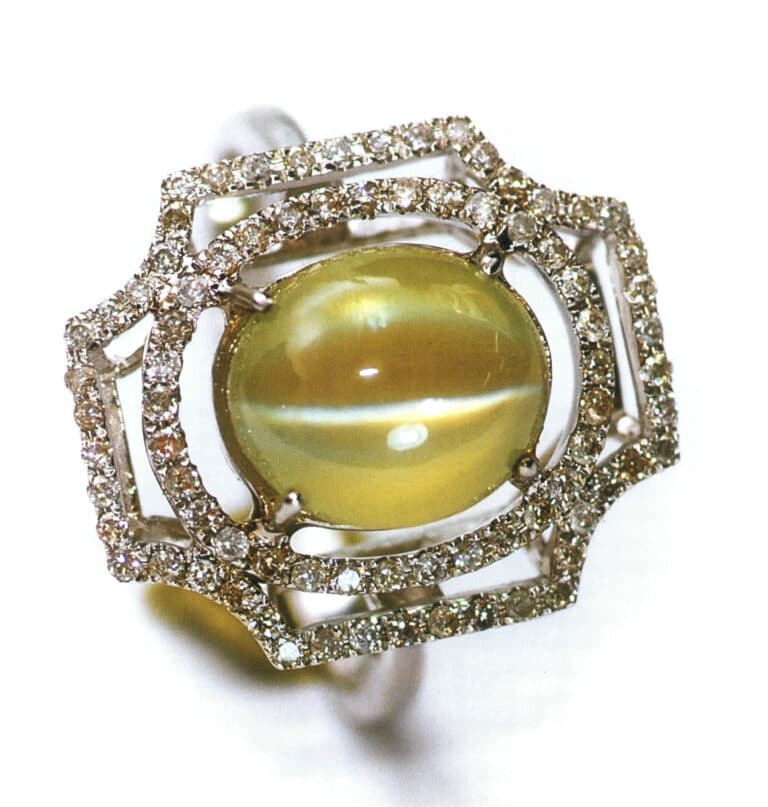
2. Alexandrite
Alexandrite is named in honor of the Russian Emperor Alexander and is commonly known as the color-changing stone. Many gemstones also exhibit color-changing phenomena, such as color-changing sapphires, color-changing garnets, and color-changing spinel. Still, when people refer to “color-changing stones,” they are usually talking about alexandrite.
Alexandrite contains beryllium, which causes the color-changing phenomenon. Under daylight or tungsten light, the gemstone will display different colors. The best color-changing stone is blue-green, which changes to purple-red and is found in the Ural Mountains of Russia, followed by those from Brazil. Alexandrite from Tanzania appears grass green under normal lighting and changes to light brown under tungsten light.
When selecting color-changing stones, first, the color change should be noticeable. Second, the clarity should be sufficient; it is rare to find both qualities in the market. Usually, stones with obvious color change have more impurities; those that are transparent and flawless do not change color as noticeably. The color-changing stones from the Ural Mountains in Russia are of the best quality, but they are almost out of production now. Currently, the best quality color-changing stones come from Brazil, while most of the color-changing rocks on the market are from Madagascar and Tanzania. For a colorchanging stone with a noticeable color change of size 1-2 carats, the market price is US$7106-11370 (changing from blue-green to purple-red). If it changes from green grass to brown-red, the price is US$4263-7106.Alexandrite stones over 10 carats with a noticeable color change are considered very rare, and the market price depends on what buyers are willing to pay.

3. Cat's-eye Alexandrite
Alexandrite cat’s-eye stones, which exhibit color change and cat’s-eye phenomenon, are the rarest and most expensive among chrysoberyl gemstones and have always been a favorite among collectors. The main production area for Alexandrite cat’s-eye stones is Tanzania in Africa, where they mostly change from deep green grass to light pink.
